Paul van Yperen's Blog, page 421
April 26, 2014
Milva
Italian singer, stage and film actress and television personality Milva (1939) is also known as 'La Rossa' (The Red). She has triumphed on stages all over the world, but she is particularly popular in France, Germany and of course in Italy, where she received the highest honours.

Italian promotion card by Dischi Cetra, Torino / Milano, 1964. Photo: Pietro Pascuttini, Roma.
The Panther of Goro
Milva was born as Maria Ilva Biolcati in Goro in the province of Ferrara in 1939.
In 1959, she won a contest for new voices, and was named the overall winner from more than seven thousand six hundred participants. In 1960 she recorded her first 7" single with Cetra Records: Édith Piaf 's song Milord.
Her real debut was on the stage of the Sanremo Music Festival in 1961, where she took third place. She has competed at the Festival a total of 15 times, the last time in 2007. The highest position she reached was second place in 1962. That year Milva was the first singer to perform Édith Piaf 's repertoire at the prestigious Olympia theatre in Paris.
In 1965, a fortunate meeting led to a definitive change in her career: Italian director Giorgio Strehler helped to develop her skills in staging and singing in Italian theatres (especially the Piccolo Teatro in Milan) and she began to perform a more committed repertoire (songs of the Italian resistance movement, songs from Bertolt Brecht's pieces, etc.).
In the following years she starred in Giorgio Strehler's production of Brecht's The Threepenny Opera which was performed in several cities of Western Europe. The press nicknamed her the ' La Pantera di Goro’ (The Panther of Goro), and she is also known as 'La Rossa', (The Red), due to the colour of her hair.
Occasionally, she appeared in Italian films of the 1960s. Her film debut was the Musicarello Canzoni a tempo di twist (Stefano Canzio, 1962) with Tiberio Murgia.
In the comedy La bellezza di Ippolita/The Beautiful Ippolita (Giancarlo Zagni, 1963), she co-starred with Gina Lollobrigida . Later she appeared in the drama D'amore si muore/For Love One Dies (Carlo Carunchio, 1972) starring Silvana Mangano .
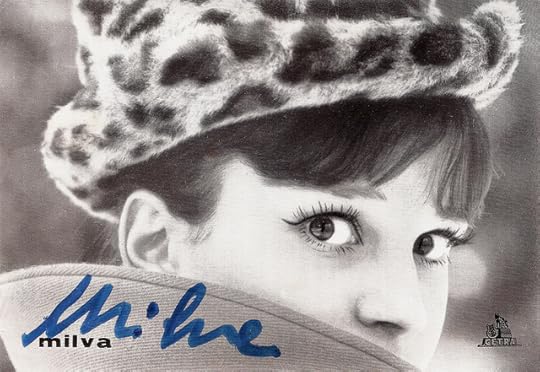
Italian promotion card by Dischi Cetra, Torino / Milano, no. 22, 1964. Photo: Pietro Pascuttini, Roma.
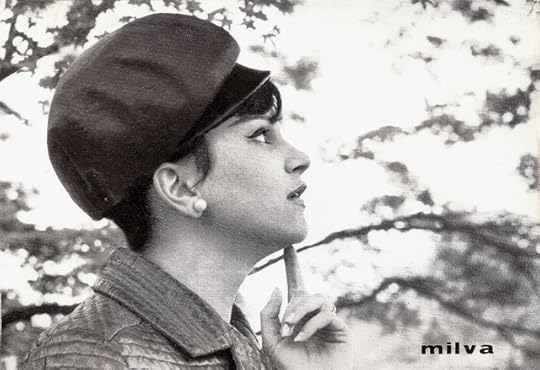
Italian promotion card by Dischi Cetra, Torino / Milano, no. 289, 1964.
Eclectic Artist
Milva is a highly eclectic artist. She performs both pop music and opera (in duet with Luciano Berio), but also plays in comedy, drama and musicals.
From 1973 to 1980, Milva was on tour with the band I Milvi. They toured though Italy, USA, Greece, France, Germany, Canada, Russia and Japan. She collaborated with such European composers and musicians as Ennio Morricone in 1965, Francis Lai in 1973, Mikis Theodorakis in 1978 (their Was ich denke became a bestselling album in Germany), Enzo Jannacci in 1980, Vangelis in 1981 and 1986, and Franco Battiato in 1982 and 1986.
Her stage productions of Bertolt Brecht's recitals and Luciano Berio's operas have toured the world's theatres. She has performed at La Scala in Milan, at the Deutsche Oper in Berlin, at the Paris Opera, in the Royal Albert Hall in London, at the 1984 Summer Olympics, at the Edinburgh Festival, and others.
She also returned to the big screen in the Italian drama Via degli specchi/Street of Mirrors (Giovanna Gagliardo, 1982) opposite Nicole Garcia. It was entered into the 33rd Berlin International Film Festival.
In 1983 she performed Édith Piaf 's repertoire again at the Olympia in Paris and again she received an ovation from the audience. The French press was very surprised how a non-French artist could interpret with such a feeling and energy the songs of Piaf.
She also hosted the TV show Al Paradise (Antonello Falqui, 1983-1985), which won the Rose d'Or (Golden Rose) of the Montreux Festival 1983. In 1984 she performed with Ástor Piazzolla the show El tango in the Les Bouffes du Nord Theatre in Paris. This was the beginning of a collaboration with Ástor Piazzolla, interpreting the nuevo tango.
She continued to play in films, including Mon beau-frère a tué ma soeur/My Brother-in-law Killed My Sister (Jacques Rouffio, 1987) with Michel Serrault and Michel Piccoli, Wherever You Are... (Krzysztof Zanussi, 1988) with Julian Sands, and Prisonnières/Women in Prison (Charlotte Silvera, 1988).

Italian postcard by Rotalfoto, Milano, no. 1067.

Italian postcard. Photo: Ricordi.
In 1997 Milva’s mentor Giorgio Strehler died. She temporarily reduced her theatre activities and focused on music only.
She received new inspiration collaborating with Thanos Mikroutsikos, James Last and Shinji Tanimura. Then she performed her fourteenth tour in Japan.
In 1998, she sang with Alexia Vassiliou on Alexia's album, Alexia - Mikis Theodorakis, a double album with new approaches to 26 Mikis Theodorakis compositions.
Milva remains to this day one of the most popular Italian personalities in the fields of music and theatre. But she still appears regularly in films too, such as Celluloide/Celluloid (Carlo Lizzani, 1995) with Giancarlo Giannini and Massimo Ghini, and Tod für fünf Stimmen/Death for Five Voices (Werner Herzog, 1996).
Later, she was also seen in the German TV series Liebesau - die andere Heimat/Liebesau - The other home (Wolfgang Panzer, 2001).
Her artistic stature has been officially recognised by the Italian, German and French republics, each of which have bestowed her with the highest honours. She is the only Italian artist in contemporary times, in fact, who is simultaneously: Chevalier of the National Order of the Legion of Honour of the French Republic (2009), Commander of the Order of Merit of the Italian Republic (2007), Officer of the Order of Merit of the Federal Republic of Germany Berlin, 2006 and Officier of the Ordre des Arts et des Lettres (1995).
Milva has a daughter, Martina, born during her marriage to Maurizio Corgnati in the early 1960s.
Milva sings Canzone (1968). Source: (YouTube).
Sources: Wikipedia and .

Italian promotion card by Dischi Cetra, Torino / Milano, 1964. Photo: Pietro Pascuttini, Roma.
The Panther of Goro
Milva was born as Maria Ilva Biolcati in Goro in the province of Ferrara in 1939.
In 1959, she won a contest for new voices, and was named the overall winner from more than seven thousand six hundred participants. In 1960 she recorded her first 7" single with Cetra Records: Édith Piaf 's song Milord.
Her real debut was on the stage of the Sanremo Music Festival in 1961, where she took third place. She has competed at the Festival a total of 15 times, the last time in 2007. The highest position she reached was second place in 1962. That year Milva was the first singer to perform Édith Piaf 's repertoire at the prestigious Olympia theatre in Paris.
In 1965, a fortunate meeting led to a definitive change in her career: Italian director Giorgio Strehler helped to develop her skills in staging and singing in Italian theatres (especially the Piccolo Teatro in Milan) and she began to perform a more committed repertoire (songs of the Italian resistance movement, songs from Bertolt Brecht's pieces, etc.).
In the following years she starred in Giorgio Strehler's production of Brecht's The Threepenny Opera which was performed in several cities of Western Europe. The press nicknamed her the ' La Pantera di Goro’ (The Panther of Goro), and she is also known as 'La Rossa', (The Red), due to the colour of her hair.
Occasionally, she appeared in Italian films of the 1960s. Her film debut was the Musicarello Canzoni a tempo di twist (Stefano Canzio, 1962) with Tiberio Murgia.
In the comedy La bellezza di Ippolita/The Beautiful Ippolita (Giancarlo Zagni, 1963), she co-starred with Gina Lollobrigida . Later she appeared in the drama D'amore si muore/For Love One Dies (Carlo Carunchio, 1972) starring Silvana Mangano .

Italian promotion card by Dischi Cetra, Torino / Milano, no. 22, 1964. Photo: Pietro Pascuttini, Roma.

Italian promotion card by Dischi Cetra, Torino / Milano, no. 289, 1964.
Eclectic Artist
Milva is a highly eclectic artist. She performs both pop music and opera (in duet with Luciano Berio), but also plays in comedy, drama and musicals.
From 1973 to 1980, Milva was on tour with the band I Milvi. They toured though Italy, USA, Greece, France, Germany, Canada, Russia and Japan. She collaborated with such European composers and musicians as Ennio Morricone in 1965, Francis Lai in 1973, Mikis Theodorakis in 1978 (their Was ich denke became a bestselling album in Germany), Enzo Jannacci in 1980, Vangelis in 1981 and 1986, and Franco Battiato in 1982 and 1986.
Her stage productions of Bertolt Brecht's recitals and Luciano Berio's operas have toured the world's theatres. She has performed at La Scala in Milan, at the Deutsche Oper in Berlin, at the Paris Opera, in the Royal Albert Hall in London, at the 1984 Summer Olympics, at the Edinburgh Festival, and others.
She also returned to the big screen in the Italian drama Via degli specchi/Street of Mirrors (Giovanna Gagliardo, 1982) opposite Nicole Garcia. It was entered into the 33rd Berlin International Film Festival.
In 1983 she performed Édith Piaf 's repertoire again at the Olympia in Paris and again she received an ovation from the audience. The French press was very surprised how a non-French artist could interpret with such a feeling and energy the songs of Piaf.
She also hosted the TV show Al Paradise (Antonello Falqui, 1983-1985), which won the Rose d'Or (Golden Rose) of the Montreux Festival 1983. In 1984 she performed with Ástor Piazzolla the show El tango in the Les Bouffes du Nord Theatre in Paris. This was the beginning of a collaboration with Ástor Piazzolla, interpreting the nuevo tango.
She continued to play in films, including Mon beau-frère a tué ma soeur/My Brother-in-law Killed My Sister (Jacques Rouffio, 1987) with Michel Serrault and Michel Piccoli, Wherever You Are... (Krzysztof Zanussi, 1988) with Julian Sands, and Prisonnières/Women in Prison (Charlotte Silvera, 1988).

Italian postcard by Rotalfoto, Milano, no. 1067.

Italian postcard. Photo: Ricordi.
In 1997 Milva’s mentor Giorgio Strehler died. She temporarily reduced her theatre activities and focused on music only.
She received new inspiration collaborating with Thanos Mikroutsikos, James Last and Shinji Tanimura. Then she performed her fourteenth tour in Japan.
In 1998, she sang with Alexia Vassiliou on Alexia's album, Alexia - Mikis Theodorakis, a double album with new approaches to 26 Mikis Theodorakis compositions.
Milva remains to this day one of the most popular Italian personalities in the fields of music and theatre. But she still appears regularly in films too, such as Celluloide/Celluloid (Carlo Lizzani, 1995) with Giancarlo Giannini and Massimo Ghini, and Tod für fünf Stimmen/Death for Five Voices (Werner Herzog, 1996).
Later, she was also seen in the German TV series Liebesau - die andere Heimat/Liebesau - The other home (Wolfgang Panzer, 2001).
Her artistic stature has been officially recognised by the Italian, German and French republics, each of which have bestowed her with the highest honours. She is the only Italian artist in contemporary times, in fact, who is simultaneously: Chevalier of the National Order of the Legion of Honour of the French Republic (2009), Commander of the Order of Merit of the Italian Republic (2007), Officer of the Order of Merit of the Federal Republic of Germany Berlin, 2006 and Officier of the Ordre des Arts et des Lettres (1995).
Milva has a daughter, Martina, born during her marriage to Maurizio Corgnati in the early 1960s.
Milva sings Canzone (1968). Source: (YouTube).
Sources: Wikipedia and .
Published on April 26, 2014 23:00
April 25, 2014
Gerd Briese
German actor and writer Gerd Briese (1897-1957) experienced a brief film career in the silent cinema of the 1920s.
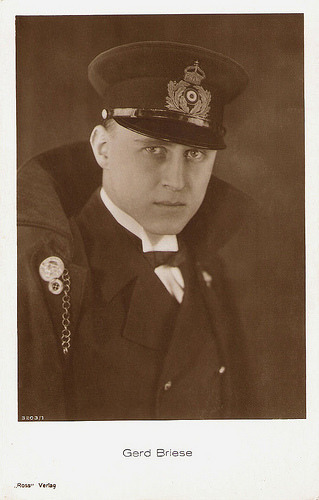
German postcard by Ross Verlag, no. 3203/1, 1928-1929.
Rose Monday
Gerd Briese was born in Thorn, West Prussia (now Torun, Poland) in 1897.
He started acting, as many did, on the stage. He made his film debut featuring in Rosenmontag/Rose Monday (Rudolf Meinert, 1924).
After that, he would play mostly supporting characters in many popular German films such as Reveille, das grosse Wecken/Reveille (Fritz Kaufmann, 1925) with Werner Krauss , which Briese also co-wrote, and Funkzauber/Radio Charm (Richard Oswald, 1927) starring Werner Krauss and Fern Andra .
As a writer he also worked on Die vom Niederrhein (Rudolf Walther-Fein, Rudolf Dworsky, 1925) starring Mady Christians , Die vom Niederrhein, 2. Teil (Rudolf Walther-Fein, 1925) and Das Gasthaus zur Ehe (Georg Jacoby, 1926).
In the next years he appeared in well-known films like the war drama U 9 Weddigen/U-boat 9 (Heinz Paul, 1927) opposite Ernst Hoffmann as two brothers who are both submarine officers, Lützows wilde verwegene Jagd/Lützow's Game Hunt (Richard Oswald, 1927), Walpurgisnacht/Walpurgis Night (James Bauer, 1927) with Vivian Gibson , and as a police officer in Meineid/Perjury (Georg Jacoby, 1929) featuring La Jana .
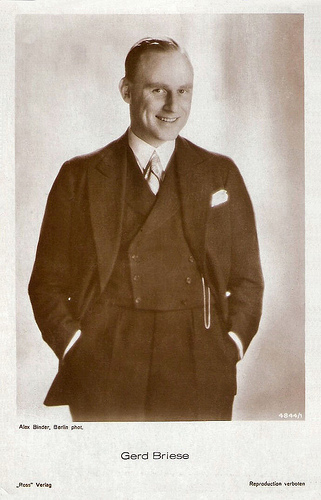
German postcard by Ross Verlag, no. 4844/1, 1929-1930. Photo: Alex Binder, Berlin
Sex in Chains
In 1928, Gerd Briese would play in a melodrama with a gay subtext, Geschlecht in Fesseln: die Sexualnot der Gefangenen/Sex in Chains ( Wilhelm Dieterle aka William Dieterle, 1928) starring Wilhelm Dieterle himself.
It’s the story of a young man who is convicted of manslaughter and sentenced to a term in prison, where he forms a close relationship with his cellmate and upon his release his wife is concerned as to how prison has changed the man she married.
After the introduction of the sound film Gerd Briese made only one talkie, Der Sittenrichter/The Customs Judge (Carl Heinz Wolff, 1929) with Erna Morena .
After that he returned to the theatre. From 1948 to 1954 he was the director of the Oldenburgisches Staatstheater.
His only film after the war was the thriller Es geschah am 20. Juli/It Happened on the 20th of July (G. W. Pabst, 1955), about the plot to assassinate Adolf Hitler.
Gerd Briese then retired and died in 1957, in Berlin.
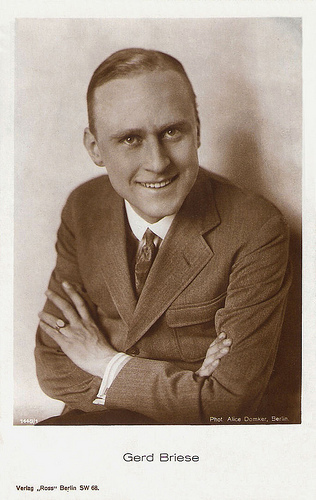
German postcard by Ross Verlag, no. 7448/1, 1932-1933. Photo: Alice Domker, Berlin.
Sources: Thomas Staedeli (Cyranos), and .

German postcard by Ross Verlag, no. 3203/1, 1928-1929.
Rose Monday
Gerd Briese was born in Thorn, West Prussia (now Torun, Poland) in 1897.
He started acting, as many did, on the stage. He made his film debut featuring in Rosenmontag/Rose Monday (Rudolf Meinert, 1924).
After that, he would play mostly supporting characters in many popular German films such as Reveille, das grosse Wecken/Reveille (Fritz Kaufmann, 1925) with Werner Krauss , which Briese also co-wrote, and Funkzauber/Radio Charm (Richard Oswald, 1927) starring Werner Krauss and Fern Andra .
As a writer he also worked on Die vom Niederrhein (Rudolf Walther-Fein, Rudolf Dworsky, 1925) starring Mady Christians , Die vom Niederrhein, 2. Teil (Rudolf Walther-Fein, 1925) and Das Gasthaus zur Ehe (Georg Jacoby, 1926).
In the next years he appeared in well-known films like the war drama U 9 Weddigen/U-boat 9 (Heinz Paul, 1927) opposite Ernst Hoffmann as two brothers who are both submarine officers, Lützows wilde verwegene Jagd/Lützow's Game Hunt (Richard Oswald, 1927), Walpurgisnacht/Walpurgis Night (James Bauer, 1927) with Vivian Gibson , and as a police officer in Meineid/Perjury (Georg Jacoby, 1929) featuring La Jana .

German postcard by Ross Verlag, no. 4844/1, 1929-1930. Photo: Alex Binder, Berlin
Sex in Chains
In 1928, Gerd Briese would play in a melodrama with a gay subtext, Geschlecht in Fesseln: die Sexualnot der Gefangenen/Sex in Chains ( Wilhelm Dieterle aka William Dieterle, 1928) starring Wilhelm Dieterle himself.
It’s the story of a young man who is convicted of manslaughter and sentenced to a term in prison, where he forms a close relationship with his cellmate and upon his release his wife is concerned as to how prison has changed the man she married.
After the introduction of the sound film Gerd Briese made only one talkie, Der Sittenrichter/The Customs Judge (Carl Heinz Wolff, 1929) with Erna Morena .
After that he returned to the theatre. From 1948 to 1954 he was the director of the Oldenburgisches Staatstheater.
His only film after the war was the thriller Es geschah am 20. Juli/It Happened on the 20th of July (G. W. Pabst, 1955), about the plot to assassinate Adolf Hitler.
Gerd Briese then retired and died in 1957, in Berlin.

German postcard by Ross Verlag, no. 7448/1, 1932-1933. Photo: Alice Domker, Berlin.
Sources: Thomas Staedeli (Cyranos), and .
Published on April 25, 2014 23:00
April 24, 2014
Merle Oberon
Indian-born British actress Merle Oberon (1911-1979) had her breakthrough as Anna Boleyn in The Private Life of Henry VIII (1933). She played leading roles in such British films as The Scarlet Pimpernel (1934), before she travelled to Hollywood to star in classics as The Dark Angel (1935) and Wuthering Heights (1939).
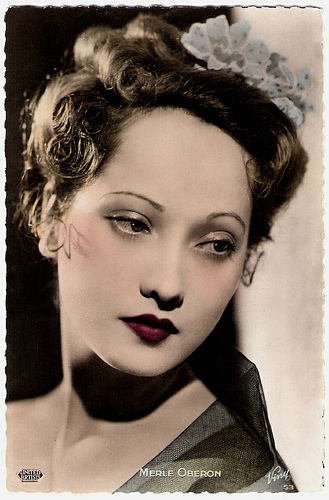
French postcard by Viny, no. 53. Photo: United Artists.
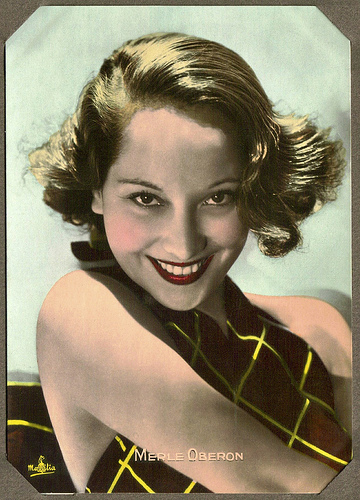
French card by Massilia. Collection: Amit Benyovits.
Queenie
From the early days of her career, Merle Oberon succeeded in establishing a fabricated history of her origins in which she said that she had been born in Tasmania, Australia. According to her birth certificate though, Oberon was born in Bombay, British India in 1911 as Estelle Merle Thompson.
Merle was given ´Queenie´ as a nickname, in honour of Queen Mary who visited India along with King George V in 1911. Her parentage has remained deliberately obscure over the years. Some sources claim Charlotte Selby, a Eurasian from Ceylon with partial Māori heritage, and Arthur Terrence O'Brien Thompson, a British mechanical engineer from Darlington, who worked in Indian Railways, as Merle's parents.
At the age of fourteen years, Charlotte had given birth to her first child Constance, in Ceylon, from a relationship with Henry Alfred Selby, an Irish foreman of a tea planter. Some sources claim that Constance was the biological mother of Merle, even though Charlotte raised Merle as her own child.
Merle believed the truth about her parentage would have destroyed her career prospects due to societal expectations and restrictions at that time. In 1914, Arthur Thompson joined the British Army and later died of pneumonia on the Western Front during the Battle of the Somme. Merle, with her mother (or grandmother) led an impoverished existence in shabby Bombay flats for a few years.
Then, in 1917, they moved to better circumstances in Calcutta. Oberon received a foundation scholarship to attend La Martiniere Calcutta for Girls, a well-known Calcutta private school. There, she was constantly taunted for her unconventional parentage and eventually quit school and had her lessons at home.
Oberon first performed with the Calcutta Amateur Dramatic Society. She was also completely enamored of the cinema and enjoyed going out to nightclubs. As she entered her teen years, she dated increasingly older, urbane men.
In 1928, she dated a former actor named Colonel Ben Finney. He promised to introduce her to Rex Ingram of Victorine Studios, if she could come to France. Oberon jumped at the offer and decided to follow the man to the studios in France.
There, Oberon and her mother found that their supposed benefactor had dodged them, but he had left a good word for her with Rex Ingram who liked Oberon's exotic appearance. He hired her as an extra in a party scene in The Three Passions (Rex Ingram, 1928) starring Alice Terry and Iván Petrovich .
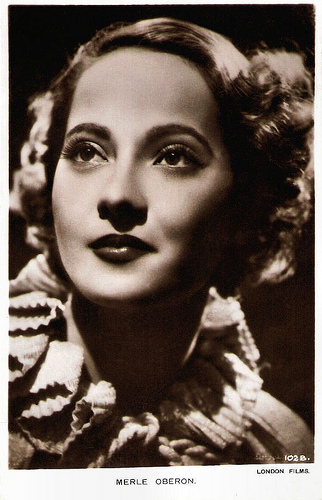 British 'Real Photograph' postcard, no. 102B. Photo: London Films.
British 'Real Photograph' postcard, no. 102B. Photo: London Films.
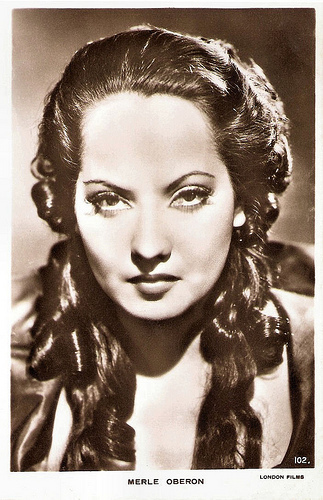
British postcard by Real Photograph, London, no. 102. Photo: London Films.
Anne Boleyn
Merle Oberon moved to England in 1928. Initially she worked as a club hostess under the name Queenie O'Brien and played as an extra in various films.
Finally she landed a part with substance: the role of Ysobel d'Aunay in Men of Tomorrow (Zoltan Korda, Leontine Sagan, 1933) with Robert Donat .
She combined a slightly frosty reserve and a distinctive British accent with a somewhat exotic beauty which suggested a passionate nature.
Her career went on to greater heights, thanks to director-producer Alexander Korda, who persuaded her to take the name under which she became famous.
Korda gave her a small but prominent role, under the name Merle Oberon, as Anne Boleyn in The Private Life of Henry VIII (1933) opposite Charles Laughton .
The film became a major success and Korda gave her leading roles, such as the temperamental dancer Antonita in The Private Life of Don Juan (Alexander Korda, 1934) opposite Douglas Fairbanks Sr., and Lady Blakeney in the The Scarlet Pimpernel (Harold Young, 1934) with Leslie Howard , who became her lover for a while.
Oberon went to great lengths to disguise her mixed-race background and when her dark-skinned mother moved in with her, she masqueraded as Oberon's maid.
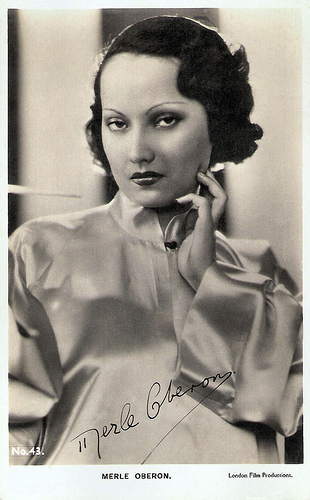
British postcard in the Film-Kurier series, no. 43. Photo: London Film Production.
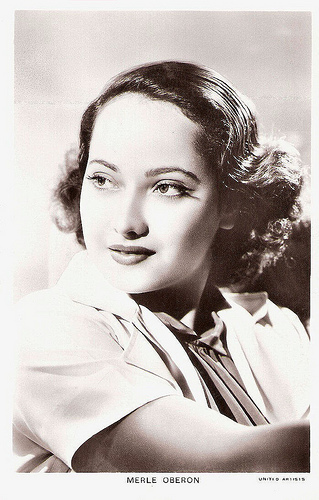
British postcard by Real Photograph, London, in the Picturegoer series, no. 820c. Photo: United Artists.
Cathy
Alexander Korda sold 'shares' of Merle Oberon´s contract to producer Samuel Goldwyn, who gave her good vehicles in Hollywood. Her 'mother' stayed behind in England.
Oberon received her only Oscar nomination as Best Actress for The Dark Angel (Sidney Franklin, 1935) opposite Fredric March.
Her work in that film resulted in offers for more quality pictures, and she appeared in several well received films, such as These Three (William Wyler, 1936), a worthy but altered adaptation of Lillian Hellman's The Children's Hour in which a scandalous lesbian romance was rewritten as a heterosexual triangle;.
Next she appeared in Over the Moon (Thornton Freeland, 1936) with Rex Harrison , and The Divorce of Lady X (Tim Whelan, 1938).
She was selected to star in Korda's epic film I, Claudius (Josef von Sternberg, 1937) as Messalina, but unfortunately the film was abandoned in mid-production after Oberon was seriously injured in a 1937 car crash. Oberon was scarred for life, but skilled lighting technicians were able to hide her injuries from cinema audiences.
She went on to appear as Cathy in Wuthering Heights (William Wyler, 1939) opposite Laurence Olivier as Heathcliff. It would become her best remembered performance.
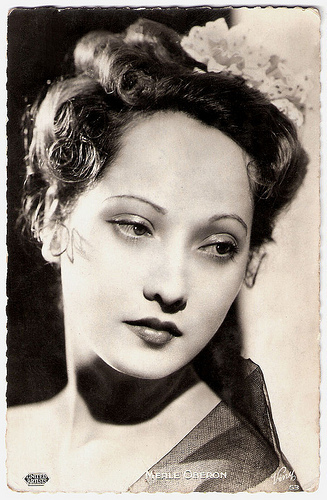
French postcard by Viny, no. 53. Photo: United Artists.
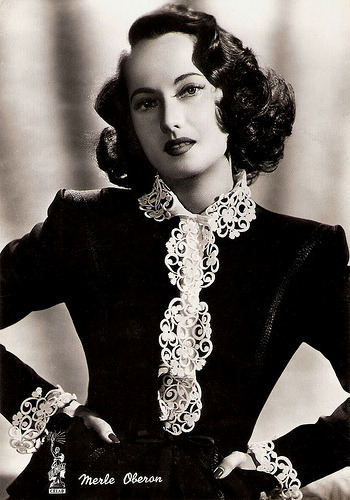
Italian postcard by Rotalfoto, Milano, no. 46. Photo: Columbia / CEIAD.
George Sand
The 1940s proved to be a very busy decade for Merle Oberon, as she appeared in no less than 15 films, including That Uncertain Feeling (Ernst Lubitsch, 1941), The Lodger (John Brahm, 1944) about Jack the Ripper, and A Song to Remember (Charles Vidor, 1945) as the tempestuous and unconventional author George Sand.
Oberon became Lady Korda upon her husband's knighthood in 1942. She divorced him in 1945, to marry cinematographer Lucien Ballard. Ballard devised a special camera light for her to eliminate her facial scars on film. The light became known as the Obie.
After her role in Berlin Express (Jacques Tourneur, 1948) she would not be seen on the screen again until four years later, as Elizabeth Rockwell in Pardon My French (Bernard Vorhaus, 1951). She then appeared as Empress Josephine in Désirée (Henry Koster, 1954) with Marlon Brando and Jean Simmons .
Unfortunately, she began appearing in fewer and fewer films over the ensuing years. After her divorce from Ballard in 1949, she married Italian-born industrialist Bruno Pagliai (from 1957 till 1973). They adopted two children, Francesca Pagliai and Bruno Pagliai Jr.
Her final film was Interval (Daniel Mann, 1973) which she also produced, and co-edited. According to Bruce Eder of AllMovie it is “a strange romantic drama that costarred her future husband Robert Wolders, that failed to find good reviews or an audience”.
After that she retired and lived in Malibu, California. In 1975 she married Robert Wolders, a Dutch actor, who would later become Audrey Hepburn 's and Leslie Caron 's companion.
In 1979 she died in Malibu after suffering a stroke at the age of 68. Her will left most of her money to be divided between her children. She left $1 million to the Motion Picture Country Home and Hospital. Her husband, Robert Wolders, got nothing, at his own request.
Merle Oberon has a star on the Hollywood Walk of Fame for her contributions to Motion Pictures. Her strange and affecting true life story was the subject of Michael (nephew of Alexander) Korda's best-seller, Queenie (1985). This book was made into a TV miniseries, Queenie (1987) starring Mia Sara.
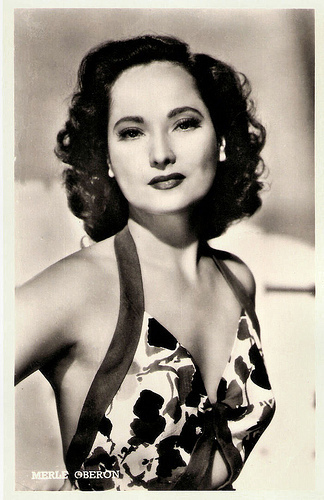
Dutch postcard by J.S.A. Photo: Universal M.P.E.
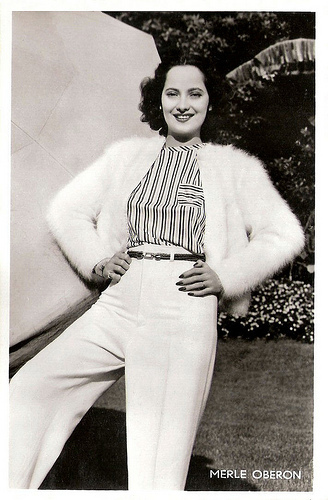
Dutch postcard.
Sources: Brian McFarlane (Encyclopedia of British Film), (IMDb), Bruce Eder (AllMovie), Turner Classic Movies, Wikipedia and .

French postcard by Viny, no. 53. Photo: United Artists.

French card by Massilia. Collection: Amit Benyovits.
Queenie
From the early days of her career, Merle Oberon succeeded in establishing a fabricated history of her origins in which she said that she had been born in Tasmania, Australia. According to her birth certificate though, Oberon was born in Bombay, British India in 1911 as Estelle Merle Thompson.
Merle was given ´Queenie´ as a nickname, in honour of Queen Mary who visited India along with King George V in 1911. Her parentage has remained deliberately obscure over the years. Some sources claim Charlotte Selby, a Eurasian from Ceylon with partial Māori heritage, and Arthur Terrence O'Brien Thompson, a British mechanical engineer from Darlington, who worked in Indian Railways, as Merle's parents.
At the age of fourteen years, Charlotte had given birth to her first child Constance, in Ceylon, from a relationship with Henry Alfred Selby, an Irish foreman of a tea planter. Some sources claim that Constance was the biological mother of Merle, even though Charlotte raised Merle as her own child.
Merle believed the truth about her parentage would have destroyed her career prospects due to societal expectations and restrictions at that time. In 1914, Arthur Thompson joined the British Army and later died of pneumonia on the Western Front during the Battle of the Somme. Merle, with her mother (or grandmother) led an impoverished existence in shabby Bombay flats for a few years.
Then, in 1917, they moved to better circumstances in Calcutta. Oberon received a foundation scholarship to attend La Martiniere Calcutta for Girls, a well-known Calcutta private school. There, she was constantly taunted for her unconventional parentage and eventually quit school and had her lessons at home.
Oberon first performed with the Calcutta Amateur Dramatic Society. She was also completely enamored of the cinema and enjoyed going out to nightclubs. As she entered her teen years, she dated increasingly older, urbane men.
In 1928, she dated a former actor named Colonel Ben Finney. He promised to introduce her to Rex Ingram of Victorine Studios, if she could come to France. Oberon jumped at the offer and decided to follow the man to the studios in France.
There, Oberon and her mother found that their supposed benefactor had dodged them, but he had left a good word for her with Rex Ingram who liked Oberon's exotic appearance. He hired her as an extra in a party scene in The Three Passions (Rex Ingram, 1928) starring Alice Terry and Iván Petrovich .
 British 'Real Photograph' postcard, no. 102B. Photo: London Films.
British 'Real Photograph' postcard, no. 102B. Photo: London Films.
British postcard by Real Photograph, London, no. 102. Photo: London Films.
Anne Boleyn
Merle Oberon moved to England in 1928. Initially she worked as a club hostess under the name Queenie O'Brien and played as an extra in various films.
Finally she landed a part with substance: the role of Ysobel d'Aunay in Men of Tomorrow (Zoltan Korda, Leontine Sagan, 1933) with Robert Donat .
She combined a slightly frosty reserve and a distinctive British accent with a somewhat exotic beauty which suggested a passionate nature.
Her career went on to greater heights, thanks to director-producer Alexander Korda, who persuaded her to take the name under which she became famous.
Korda gave her a small but prominent role, under the name Merle Oberon, as Anne Boleyn in The Private Life of Henry VIII (1933) opposite Charles Laughton .
The film became a major success and Korda gave her leading roles, such as the temperamental dancer Antonita in The Private Life of Don Juan (Alexander Korda, 1934) opposite Douglas Fairbanks Sr., and Lady Blakeney in the The Scarlet Pimpernel (Harold Young, 1934) with Leslie Howard , who became her lover for a while.
Oberon went to great lengths to disguise her mixed-race background and when her dark-skinned mother moved in with her, she masqueraded as Oberon's maid.

British postcard in the Film-Kurier series, no. 43. Photo: London Film Production.

British postcard by Real Photograph, London, in the Picturegoer series, no. 820c. Photo: United Artists.
Cathy
Alexander Korda sold 'shares' of Merle Oberon´s contract to producer Samuel Goldwyn, who gave her good vehicles in Hollywood. Her 'mother' stayed behind in England.
Oberon received her only Oscar nomination as Best Actress for The Dark Angel (Sidney Franklin, 1935) opposite Fredric March.
Her work in that film resulted in offers for more quality pictures, and she appeared in several well received films, such as These Three (William Wyler, 1936), a worthy but altered adaptation of Lillian Hellman's The Children's Hour in which a scandalous lesbian romance was rewritten as a heterosexual triangle;.
Next she appeared in Over the Moon (Thornton Freeland, 1936) with Rex Harrison , and The Divorce of Lady X (Tim Whelan, 1938).
She was selected to star in Korda's epic film I, Claudius (Josef von Sternberg, 1937) as Messalina, but unfortunately the film was abandoned in mid-production after Oberon was seriously injured in a 1937 car crash. Oberon was scarred for life, but skilled lighting technicians were able to hide her injuries from cinema audiences.
She went on to appear as Cathy in Wuthering Heights (William Wyler, 1939) opposite Laurence Olivier as Heathcliff. It would become her best remembered performance.

French postcard by Viny, no. 53. Photo: United Artists.

Italian postcard by Rotalfoto, Milano, no. 46. Photo: Columbia / CEIAD.
George Sand
The 1940s proved to be a very busy decade for Merle Oberon, as she appeared in no less than 15 films, including That Uncertain Feeling (Ernst Lubitsch, 1941), The Lodger (John Brahm, 1944) about Jack the Ripper, and A Song to Remember (Charles Vidor, 1945) as the tempestuous and unconventional author George Sand.
Oberon became Lady Korda upon her husband's knighthood in 1942. She divorced him in 1945, to marry cinematographer Lucien Ballard. Ballard devised a special camera light for her to eliminate her facial scars on film. The light became known as the Obie.
After her role in Berlin Express (Jacques Tourneur, 1948) she would not be seen on the screen again until four years later, as Elizabeth Rockwell in Pardon My French (Bernard Vorhaus, 1951). She then appeared as Empress Josephine in Désirée (Henry Koster, 1954) with Marlon Brando and Jean Simmons .
Unfortunately, she began appearing in fewer and fewer films over the ensuing years. After her divorce from Ballard in 1949, she married Italian-born industrialist Bruno Pagliai (from 1957 till 1973). They adopted two children, Francesca Pagliai and Bruno Pagliai Jr.
Her final film was Interval (Daniel Mann, 1973) which she also produced, and co-edited. According to Bruce Eder of AllMovie it is “a strange romantic drama that costarred her future husband Robert Wolders, that failed to find good reviews or an audience”.
After that she retired and lived in Malibu, California. In 1975 she married Robert Wolders, a Dutch actor, who would later become Audrey Hepburn 's and Leslie Caron 's companion.
In 1979 she died in Malibu after suffering a stroke at the age of 68. Her will left most of her money to be divided between her children. She left $1 million to the Motion Picture Country Home and Hospital. Her husband, Robert Wolders, got nothing, at his own request.
Merle Oberon has a star on the Hollywood Walk of Fame for her contributions to Motion Pictures. Her strange and affecting true life story was the subject of Michael (nephew of Alexander) Korda's best-seller, Queenie (1985). This book was made into a TV miniseries, Queenie (1987) starring Mia Sara.

Dutch postcard by J.S.A. Photo: Universal M.P.E.

Dutch postcard.
Sources: Brian McFarlane (Encyclopedia of British Film), (IMDb), Bruce Eder (AllMovie), Turner Classic Movies, Wikipedia and .
Published on April 24, 2014 23:00
Emmanuelle Béart
Since 1972, French actress Emmanuelle Béart (1963) has appeared in over 50 film and television productions. Initially cast for her extraordinary beauty, Béart has emerged over the years as one of France's best actresses. The sapphire-eyed Béart has been nominated eight times for a César Award and she won for Best Supporting Actress in the film Manon des Sources (1986).
Romanian postcard by Casa Filmului Acin, no 43033.
A Beautiful Blonde Shepherd
Emmanuelle Béart was born Emmanuelle Béhart-Hasson in St. Tropez (some sources say Gassin), on the French Riviera, in 1963. She was the daughter of Geneviève Galéa, a former model, and Guy Béart, a singer and poet. Following her parents' divorce, Emmanuelle was raised by her mother in Gassin, a remote mountain village in Provence.
In her teens she appeared in bit parts on television and in the offbeat crime drama La course du lièvre à travers les champs/And Hope To Die (René Clément, 1972) starring Jean-Louis Trintignant .
In her late teens she spent her summer vacation with the English speaking family of a close friend of her father in Montreal. At the end of the summer the family invited her to stay with them and complete her baccalauréat at Collège international Marie de France. In Montreal, she met director Robert Altman, who encouraged her to become an actress. She took a screen test for him, but nothing came of it.
Upon graduating she returned to France to attend drama school in Paris. She appeared in the last erotic film of photographer David Hamilton, Premier Desirs/First Desires (1984).
For both her roles in Un amour interdit/A Strange Passion (Jean-Pierre Dougnac, 1985) and the comedy L'amour en douce/Love on the Quiet (Édouard Molinaro, 1986), she was nominated for a César as Most Promising Actress.
In 1986 she achieved fame with as a beautiful blonde shepherd and also vengeful daughter of the late Jean de Florette in Manon des Sources/Manon of the Spring (Claude Berri, 1986) opposite Yves Montand . Manon des Sources is the critically acclaimed and commercially successful sequel to Jean de Florette, adapted from the 1966 two-volume novel by Marcel Pagnol, who wrote it based on his own earlier film of the same title. For her performance, she won the 1987 César Award for Best Supporting Actress.
Less successful was her Hollywood stint as an angel in the fantasy comedy Date with an Angel (Tom McLoughlin, 1987) starring Phoebe Cates and Michael E. Knight.
In the following years, she was five times nominated for César the Award for Best Actress: Les Enfants du désordre/Children of Chaos (Yannick Bellon, 1990), La Belle Noiseuse/The Beautiful Troublemaker (Jacques Rivette, 1990), Un cœur en hiver/A Heart in Winter (Claude Sautet, 1993), Nelly et Monsieur Arnaud/Nelly and Mr Arnaud (Claude Sautet, 1996) and Les Destinées Sentimentales/Sentimental Destinies (Olivier Assayas, 2001).
Other interesting films were Il viaggio di Capitan Fracassa/Captain Fracassa's Journey (Ettore Scola, 1990) with Vincent Perez, the drama J'embrasse pas/I Don't Kiss (André Téchiné, 1991), starring Manuel Blanc and Philippe Noiret, and L'Enfer/Hell (Claude Chabrol, 1994), adapted from the screenplay by Henri-Georges Clouzot for the unfinished film L'Enfer (1964).
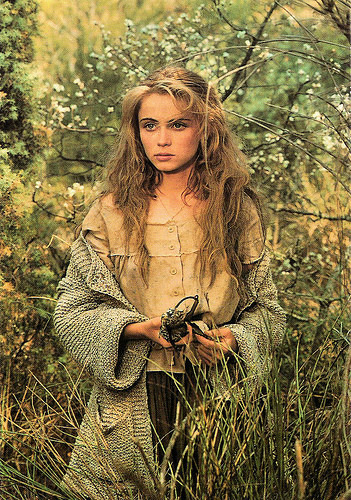
French postcard by Ediions F. Nugeron, no. 3. Photo: Collection de l'Ecole de Cinéma Camiris. Publicity still for Manon des Sources/Manon of the Spring (Claude Berri, 1986).
Mission: Impossible
In the mid-1980s, Emmanuelle Béart began a relationship with Daniel Auteuil, her co-star in L'amour en douce/Love on the Quiet, Manon des Sources/Manon of the Spring, Un cœur en hiver/A Heart in Winter and Une femme française/A French Woman. They married in 1993 but divorced in 1998.
For her starring role in Une femme française/A French Woman (Régis Wargnier, 1995), she won the Silver St. George for Best Actress award at the 19th Moscow International Film Festival.
She did another role in a Hollywood production, Mission: Impossible (Brian De Palma, 1996), produced by and starring Tom Cruise. The film was the third-highest-grossing of the year and received positive reviews from film critics, but her window-dressing role did not lead to more American films.
In France, she found more interesting parts in the period drama Le Temps retrouvé/Time Regained (Raúl Ruiz, 1999), an adaptation of the final volume of In Search of Lost Time by Marcel Proust, and in the dark comedy musical 8 Femmes/8 Women (François Ozon, 2002), in which she parodied the erotic French maid stereotype.
In the 5 May 2003 issue of the French edition of Elle magazine, Béart, aged 39, appeared nude with a younger man. The entire print-run of 550,000 copies sold out in just three days, making it the biggest-selling issue in the fashion glossy's long history.
In 2007, she participated in Les témoins/The Witnesses (André Téchiné, 2007) about the first outbreak of the AIDS epidemic.
In addition to her screen work, Béart is also known for her social activism. She is an ambassador for UNICEF, and is known for her opposition to France's anti-immigration legislation. In 1996, she made headlines when, defending the rights of the ‘sans-papiers’ (black illegal immigrants), she was forcibly removed from a siege in a Paris church.
She married twice and has two children. Her first husband was frequent co-star Daniel Auteuil (1993-1995), with whom she has a daughter, Nelly Auteuil (1993). Later, Béart was romantically linked to music producer David Moreau, with whom she has a son Johan Moreau (1996), and to film producer Vincent Meyer for two years until his suicide in May 2003. In 2008, she married actor Michaël Cohen.
Trailer for Manon des Sources/Manon of the Spring (1986). Source: Ageless Trailers (YouTube).
Trailer for Le Temps retrouvé/Time Regained (1999). Source: Boudward (YouTube).
Sources: Rebecca Flint Marx (AllMovie), (IMDb), Wikipedia, and .
Romanian postcard by Casa Filmului Acin, no 43033.
A Beautiful Blonde Shepherd
Emmanuelle Béart was born Emmanuelle Béhart-Hasson in St. Tropez (some sources say Gassin), on the French Riviera, in 1963. She was the daughter of Geneviève Galéa, a former model, and Guy Béart, a singer and poet. Following her parents' divorce, Emmanuelle was raised by her mother in Gassin, a remote mountain village in Provence.
In her teens she appeared in bit parts on television and in the offbeat crime drama La course du lièvre à travers les champs/And Hope To Die (René Clément, 1972) starring Jean-Louis Trintignant .
In her late teens she spent her summer vacation with the English speaking family of a close friend of her father in Montreal. At the end of the summer the family invited her to stay with them and complete her baccalauréat at Collège international Marie de France. In Montreal, she met director Robert Altman, who encouraged her to become an actress. She took a screen test for him, but nothing came of it.
Upon graduating she returned to France to attend drama school in Paris. She appeared in the last erotic film of photographer David Hamilton, Premier Desirs/First Desires (1984).
For both her roles in Un amour interdit/A Strange Passion (Jean-Pierre Dougnac, 1985) and the comedy L'amour en douce/Love on the Quiet (Édouard Molinaro, 1986), she was nominated for a César as Most Promising Actress.
In 1986 she achieved fame with as a beautiful blonde shepherd and also vengeful daughter of the late Jean de Florette in Manon des Sources/Manon of the Spring (Claude Berri, 1986) opposite Yves Montand . Manon des Sources is the critically acclaimed and commercially successful sequel to Jean de Florette, adapted from the 1966 two-volume novel by Marcel Pagnol, who wrote it based on his own earlier film of the same title. For her performance, she won the 1987 César Award for Best Supporting Actress.
Less successful was her Hollywood stint as an angel in the fantasy comedy Date with an Angel (Tom McLoughlin, 1987) starring Phoebe Cates and Michael E. Knight.
In the following years, she was five times nominated for César the Award for Best Actress: Les Enfants du désordre/Children of Chaos (Yannick Bellon, 1990), La Belle Noiseuse/The Beautiful Troublemaker (Jacques Rivette, 1990), Un cœur en hiver/A Heart in Winter (Claude Sautet, 1993), Nelly et Monsieur Arnaud/Nelly and Mr Arnaud (Claude Sautet, 1996) and Les Destinées Sentimentales/Sentimental Destinies (Olivier Assayas, 2001).
Other interesting films were Il viaggio di Capitan Fracassa/Captain Fracassa's Journey (Ettore Scola, 1990) with Vincent Perez, the drama J'embrasse pas/I Don't Kiss (André Téchiné, 1991), starring Manuel Blanc and Philippe Noiret, and L'Enfer/Hell (Claude Chabrol, 1994), adapted from the screenplay by Henri-Georges Clouzot for the unfinished film L'Enfer (1964).

French postcard by Ediions F. Nugeron, no. 3. Photo: Collection de l'Ecole de Cinéma Camiris. Publicity still for Manon des Sources/Manon of the Spring (Claude Berri, 1986).
Mission: Impossible
In the mid-1980s, Emmanuelle Béart began a relationship with Daniel Auteuil, her co-star in L'amour en douce/Love on the Quiet, Manon des Sources/Manon of the Spring, Un cœur en hiver/A Heart in Winter and Une femme française/A French Woman. They married in 1993 but divorced in 1998.
For her starring role in Une femme française/A French Woman (Régis Wargnier, 1995), she won the Silver St. George for Best Actress award at the 19th Moscow International Film Festival.
She did another role in a Hollywood production, Mission: Impossible (Brian De Palma, 1996), produced by and starring Tom Cruise. The film was the third-highest-grossing of the year and received positive reviews from film critics, but her window-dressing role did not lead to more American films.
In France, she found more interesting parts in the period drama Le Temps retrouvé/Time Regained (Raúl Ruiz, 1999), an adaptation of the final volume of In Search of Lost Time by Marcel Proust, and in the dark comedy musical 8 Femmes/8 Women (François Ozon, 2002), in which she parodied the erotic French maid stereotype.
In the 5 May 2003 issue of the French edition of Elle magazine, Béart, aged 39, appeared nude with a younger man. The entire print-run of 550,000 copies sold out in just three days, making it the biggest-selling issue in the fashion glossy's long history.
In 2007, she participated in Les témoins/The Witnesses (André Téchiné, 2007) about the first outbreak of the AIDS epidemic.
In addition to her screen work, Béart is also known for her social activism. She is an ambassador for UNICEF, and is known for her opposition to France's anti-immigration legislation. In 1996, she made headlines when, defending the rights of the ‘sans-papiers’ (black illegal immigrants), she was forcibly removed from a siege in a Paris church.
She married twice and has two children. Her first husband was frequent co-star Daniel Auteuil (1993-1995), with whom she has a daughter, Nelly Auteuil (1993). Later, Béart was romantically linked to music producer David Moreau, with whom she has a son Johan Moreau (1996), and to film producer Vincent Meyer for two years until his suicide in May 2003. In 2008, she married actor Michaël Cohen.
Trailer for Manon des Sources/Manon of the Spring (1986). Source: Ageless Trailers (YouTube).
Trailer for Le Temps retrouvé/Time Regained (1999). Source: Boudward (YouTube).
Sources: Rebecca Flint Marx (AllMovie), (IMDb), Wikipedia, and .
Published on April 24, 2014 08:42
April 22, 2014
Julius von Szöreghy
Hungarian actor and film director Julius von Szöreghy (1883-1943) was one of the busiest supporting actors of the German and Austrian cinema in the second half of the 1920s.
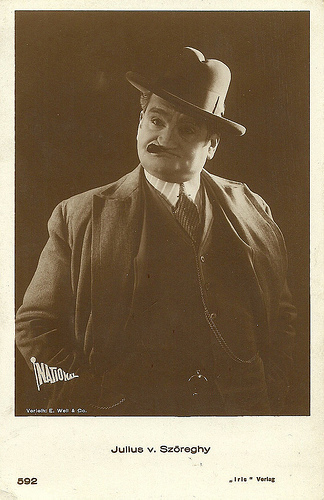
Austrian postcard by Iris Verlag, no. 592. Photo: Verleih E. Weill & Co. / National. Collection: Didier Hanson.
The Largest And Most Expensive Austrian Film Production
Julius von Szöreghy was born Gyula Szöreghy in 1883 in Budapest. He debuted as an actor in 1902 and played at various theatres, for example, in Temesvár and Buda.
His film appearances began in 1913. Among his silent Hungarian films are Mary Ann (Alexander Korda, 1918) starring Ica von Lenkeffy, and the drama Fehér rózsa/White Rose (Alexander Korda, 1919) starring María Corda . Fehér rózsa/White Rose was released by the state-owned Hungarian film industry during the Hungarian Soviet Republic, although production had begun before the regime came to power.
He also played Sikes in Twist Olivér/Oliver Twist (Márton Garas, 1919), a Hungarian adaptation of the novel Oliver Twist by Charles Dickens.
In 1920, he moved to Vienna in Austria. There he changed his name to Julius von Szöreghy. Alexander Korda worked there for the Sascha-Film company.
Korda gave him a part in the silent adventure film Herren der Meere/Masters of the Sea (Alexander Korda, 1922) starring Victor Varconi . Several other Hungarian exiles also worked on the film, including the producer Arnold Pressburger and scriptwriter Ernest Vajda. The film's storyline offered a romantic view of modern-day pirates and their pursuit of treasure.
It was followed by another adventure epic Eine versunkene Welt/A Vanished World (Alexander Korda, 1922). Von Szöreghy was also among the gigantic cast of the silent epic Sodom und Gomorrha/Sodom and Gomorrah (Mihály Kertész a.k.a. Michael Curtiz, 1922), the largest and most expensive production in Austrian film history. In the creation of the film between 3,000 and 14,000 performers, extras and crew were employed.
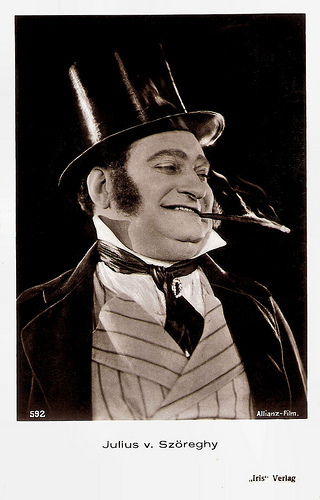
Austrian postcard by Iris Verlag, no. 592. Photo: Allianz Film.
Strange Relatives, Servants, Petty Bourgeois And Officials
Since 1925, Julius von Szöreghy participated in German productions as the war film Die dritte Eskadron/The Third Squadron (Carl Wilhelm, 1926), the comedy Der Fürst von Pappenheim/The Masked Mannequin (Richard Eichberg, 1927) and Das tanzende Wien/Dancing Vienna ( Friedrich Zelnik a.k.a. Frederic Zelnik, 1927) starring Lya Mara .
During the second half of the 1920s, he became one of the busiest supporting actor in the German-Austrian silent cinema. The burly Szöreghy embodied usually comic characters, including strange relatives, servants, petty bourgeois and officials.
Among his best known films were also Eine Dubarry von heute/A Dubarry of today (Alexander Korda, 1927) featuring María Corda , and Luther (Hans Kyser, 1928), about the life of Martin Luther, father of the Protestant Reformation. The silent film starred Eugen Klöpfer as Luther and Theodor Loos as Philipp Melanchthon, and was written by Berlin Cathedral chaplain Bruno Doehring.
Von Szöreghy also participated in the German-British romance Der fesche Husar/The Gallant Hussar (Géza von Bolváry, 1928) starring Ivor Novello . The film was a co-production made under an agreement between Gainsborough Pictures and the German studio Felsom-Film and was shot in Berlin.
Von Szöreghy seldom received starring roles. An exception was Mikosch rückt ein/Mickosch engages (Rolf Randolf, 1928) in which he played a factory owner. He also occasionally directed himself, such as in Der Onkel aus Sumatra/The uncle from Sumatra (1930) with Wolf Albach-Retty .
The transition to the sound film was no problem for him and he continued his career in Germany seamlessly during the early 1930s. When the National Socialists seized the power in Germany he returned to Budapest in 1934.
In Hungary, he continued his film career in such productions as Szervusz Péter!/Hello Peter! (Sándor Szlatinay, 1939), the musical Háry János (Frigyes Bán, 1941), and Régi keringö/Old Waltz (Viktor Bánky, 1941), all starring Antal Páger.
Julius von Szöreghy died in 1943 in Budapest. His final film was the German revue film Karneval der Liebe/Carnival of Love (Paul Martin, 1943), which had been partly filmed in Budapest. He was married to actress René Sello.
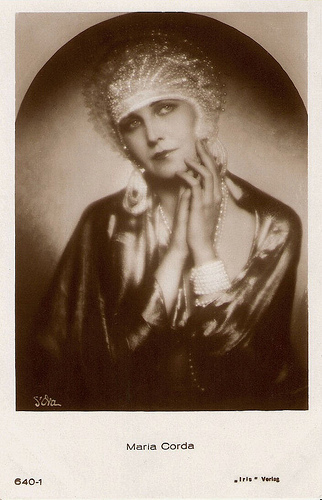
María Corda . Austrian postcard by Iris Verlag, no. 640-1. Photo: D'Ora (Dora Kallmus).
Sources: Thomas Staedeli (Cyranos), Wikipedia (German and English), and .

Austrian postcard by Iris Verlag, no. 592. Photo: Verleih E. Weill & Co. / National. Collection: Didier Hanson.
The Largest And Most Expensive Austrian Film Production
Julius von Szöreghy was born Gyula Szöreghy in 1883 in Budapest. He debuted as an actor in 1902 and played at various theatres, for example, in Temesvár and Buda.
His film appearances began in 1913. Among his silent Hungarian films are Mary Ann (Alexander Korda, 1918) starring Ica von Lenkeffy, and the drama Fehér rózsa/White Rose (Alexander Korda, 1919) starring María Corda . Fehér rózsa/White Rose was released by the state-owned Hungarian film industry during the Hungarian Soviet Republic, although production had begun before the regime came to power.
He also played Sikes in Twist Olivér/Oliver Twist (Márton Garas, 1919), a Hungarian adaptation of the novel Oliver Twist by Charles Dickens.
In 1920, he moved to Vienna in Austria. There he changed his name to Julius von Szöreghy. Alexander Korda worked there for the Sascha-Film company.
Korda gave him a part in the silent adventure film Herren der Meere/Masters of the Sea (Alexander Korda, 1922) starring Victor Varconi . Several other Hungarian exiles also worked on the film, including the producer Arnold Pressburger and scriptwriter Ernest Vajda. The film's storyline offered a romantic view of modern-day pirates and their pursuit of treasure.
It was followed by another adventure epic Eine versunkene Welt/A Vanished World (Alexander Korda, 1922). Von Szöreghy was also among the gigantic cast of the silent epic Sodom und Gomorrha/Sodom and Gomorrah (Mihály Kertész a.k.a. Michael Curtiz, 1922), the largest and most expensive production in Austrian film history. In the creation of the film between 3,000 and 14,000 performers, extras and crew were employed.

Austrian postcard by Iris Verlag, no. 592. Photo: Allianz Film.
Strange Relatives, Servants, Petty Bourgeois And Officials
Since 1925, Julius von Szöreghy participated in German productions as the war film Die dritte Eskadron/The Third Squadron (Carl Wilhelm, 1926), the comedy Der Fürst von Pappenheim/The Masked Mannequin (Richard Eichberg, 1927) and Das tanzende Wien/Dancing Vienna ( Friedrich Zelnik a.k.a. Frederic Zelnik, 1927) starring Lya Mara .
During the second half of the 1920s, he became one of the busiest supporting actor in the German-Austrian silent cinema. The burly Szöreghy embodied usually comic characters, including strange relatives, servants, petty bourgeois and officials.
Among his best known films were also Eine Dubarry von heute/A Dubarry of today (Alexander Korda, 1927) featuring María Corda , and Luther (Hans Kyser, 1928), about the life of Martin Luther, father of the Protestant Reformation. The silent film starred Eugen Klöpfer as Luther and Theodor Loos as Philipp Melanchthon, and was written by Berlin Cathedral chaplain Bruno Doehring.
Von Szöreghy also participated in the German-British romance Der fesche Husar/The Gallant Hussar (Géza von Bolváry, 1928) starring Ivor Novello . The film was a co-production made under an agreement between Gainsborough Pictures and the German studio Felsom-Film and was shot in Berlin.
Von Szöreghy seldom received starring roles. An exception was Mikosch rückt ein/Mickosch engages (Rolf Randolf, 1928) in which he played a factory owner. He also occasionally directed himself, such as in Der Onkel aus Sumatra/The uncle from Sumatra (1930) with Wolf Albach-Retty .
The transition to the sound film was no problem for him and he continued his career in Germany seamlessly during the early 1930s. When the National Socialists seized the power in Germany he returned to Budapest in 1934.
In Hungary, he continued his film career in such productions as Szervusz Péter!/Hello Peter! (Sándor Szlatinay, 1939), the musical Háry János (Frigyes Bán, 1941), and Régi keringö/Old Waltz (Viktor Bánky, 1941), all starring Antal Páger.
Julius von Szöreghy died in 1943 in Budapest. His final film was the German revue film Karneval der Liebe/Carnival of Love (Paul Martin, 1943), which had been partly filmed in Budapest. He was married to actress René Sello.

María Corda . Austrian postcard by Iris Verlag, no. 640-1. Photo: D'Ora (Dora Kallmus).
Sources: Thomas Staedeli (Cyranos), Wikipedia (German and English), and .
Published on April 22, 2014 23:00
April 21, 2014
Lise Bourdin
Glamorous French actress Lise Bourdin (1925) is known for her roles in international films during the 1950s. Among her best known films are La donna del fiume/The River Girl (1954) and the Billy Wilder classic Love in the Afternoon (1957).
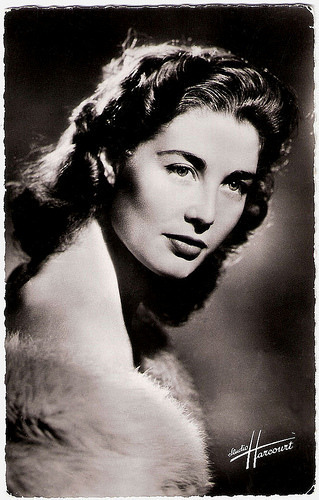
French postcard by Editions du Globe, Paris, no. 279. Photo: Studio Harcourt.
Miss Arch of Triumph
Lise Bourdin was born as Louise Marie Odette Bourdin-Perrier in 1925 in Néris-les-Bains, Allier, France. She was the sister of radio maker and orchestra leader Roland Bourtin.
Lise began her career as a model and 1948 she toured the United States on behalf of American Aid to France, Inc., and the American Overseas Aid-United Nations Appeal for Children as well as to celebrate the 100th anniversary of the rededication of L’Arc de Triomphe.
As 'Miss Arch of Triumph', she promoted the American film Arch of Triumph (Lewis Milestone, 1948) with Ingrid Bergman and Charles Boyer .
She made her first film appearance uncredited in the crime film Scandale aux Champs-Élysées/Scandal at the Champs-Elusées (Roger Blanc, 1949) starring Pierre Renoir . A small part followed in Les mémoires de la vache Yolande/The memoirs of the cow Yolande (Ernst Neubach, 1951) starring Rellys.
Then followed her breakthrough with a co-starring part in a ‘shocking’ drama about unwed mothers, Les enfants de l'amour/Children of Love (Léonide Moguy, 1953) starring Etchika Choureau . The now completely forgotten film was an international success, promoted in the US with taglines like “Unwed Mothers! They Come From Everywhere, From Every Class” and “Startling! Shocking! Rips the Veil of Secrecy From Love's Most Shameful Sin!” The beautiful starlet soon appeared in films outside of France.
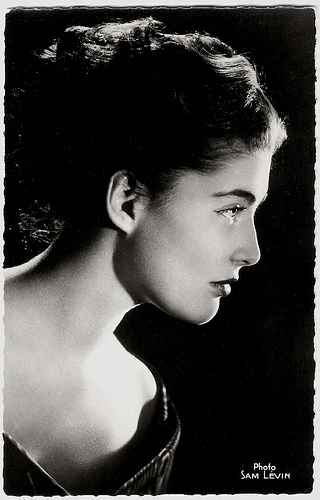
French postcard by Editions du Globe, Paris, no. 317. Photo: Sam Lévin.
Hot Pants
In Italy Lise Bourdin appeared in Scuola elementare/Elementary School (Alberto Lattuada, 1954) and with Sophia Loren , both in hot pants, in the rice picker drama La donna del fiume/ The River Girl (Mario Soldati, 1954).
She also appeared in the American TV series Sherlock Holmes (1955), which was filmed in France. One of her best known roles is Madame X, seduced by Gary Cooper in Love in the Afternoon (Billy Wilder, 1957).
That year she also played a princess in the French adventure film La rivière des trois jonques/The River of Three Junks (André Pergament, 1957) and was one of the beautiful ladies around two-fisted Eddie Constantine in the crime film Ces dames préfèrent le mambo/Dishonorable Discharge (Bernard Borderie, 1957).
In Germany she appeared in the Caterina Valente vehicle ...und abends in die Scala/And that evening in the Scala (Erik Ode, 1958) and back in France in Quai des illusions/Avenue of illusions (Émile Couzinet 1959) starring Gaby Morlay .
Her final appearance was in the American war film The Last Blitzkrieg (Arthur Dreifuss, 1960) starring Van Johnson.
In 1963, she married Roberto Seabra, a wealthy Brazilian, whom she divorced again in 1965. In 1974 she became the partner of Raymond Marcellin, Interior minister of France.
Lise Bourdin lives in Paris.
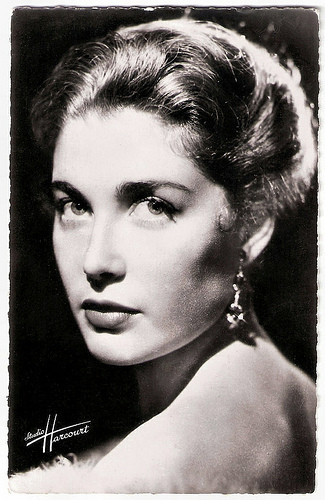
French postcard by Editions du Globe, Paris, no. 282. Photo: Studio Harcourt.
Sources: Glamour Girls of the Silver Screen, AllMovie, Wikipedia (French), and .

French postcard by Editions du Globe, Paris, no. 279. Photo: Studio Harcourt.
Miss Arch of Triumph
Lise Bourdin was born as Louise Marie Odette Bourdin-Perrier in 1925 in Néris-les-Bains, Allier, France. She was the sister of radio maker and orchestra leader Roland Bourtin.
Lise began her career as a model and 1948 she toured the United States on behalf of American Aid to France, Inc., and the American Overseas Aid-United Nations Appeal for Children as well as to celebrate the 100th anniversary of the rededication of L’Arc de Triomphe.
As 'Miss Arch of Triumph', she promoted the American film Arch of Triumph (Lewis Milestone, 1948) with Ingrid Bergman and Charles Boyer .
She made her first film appearance uncredited in the crime film Scandale aux Champs-Élysées/Scandal at the Champs-Elusées (Roger Blanc, 1949) starring Pierre Renoir . A small part followed in Les mémoires de la vache Yolande/The memoirs of the cow Yolande (Ernst Neubach, 1951) starring Rellys.
Then followed her breakthrough with a co-starring part in a ‘shocking’ drama about unwed mothers, Les enfants de l'amour/Children of Love (Léonide Moguy, 1953) starring Etchika Choureau . The now completely forgotten film was an international success, promoted in the US with taglines like “Unwed Mothers! They Come From Everywhere, From Every Class” and “Startling! Shocking! Rips the Veil of Secrecy From Love's Most Shameful Sin!” The beautiful starlet soon appeared in films outside of France.

French postcard by Editions du Globe, Paris, no. 317. Photo: Sam Lévin.
Hot Pants
In Italy Lise Bourdin appeared in Scuola elementare/Elementary School (Alberto Lattuada, 1954) and with Sophia Loren , both in hot pants, in the rice picker drama La donna del fiume/ The River Girl (Mario Soldati, 1954).
She also appeared in the American TV series Sherlock Holmes (1955), which was filmed in France. One of her best known roles is Madame X, seduced by Gary Cooper in Love in the Afternoon (Billy Wilder, 1957).
That year she also played a princess in the French adventure film La rivière des trois jonques/The River of Three Junks (André Pergament, 1957) and was one of the beautiful ladies around two-fisted Eddie Constantine in the crime film Ces dames préfèrent le mambo/Dishonorable Discharge (Bernard Borderie, 1957).
In Germany she appeared in the Caterina Valente vehicle ...und abends in die Scala/And that evening in the Scala (Erik Ode, 1958) and back in France in Quai des illusions/Avenue of illusions (Émile Couzinet 1959) starring Gaby Morlay .
Her final appearance was in the American war film The Last Blitzkrieg (Arthur Dreifuss, 1960) starring Van Johnson.
In 1963, she married Roberto Seabra, a wealthy Brazilian, whom she divorced again in 1965. In 1974 she became the partner of Raymond Marcellin, Interior minister of France.
Lise Bourdin lives in Paris.

French postcard by Editions du Globe, Paris, no. 282. Photo: Studio Harcourt.
Sources: Glamour Girls of the Silver Screen, AllMovie, Wikipedia (French), and .
Published on April 21, 2014 23:00
April 20, 2014
Roland Toutain
Seductive daredevil Roland Toutain (1905-1977) was a French actor, songwriter and stuntman. He is best known for playing the aviator André Jurieux in Jean Renoir's film La Règle du jeu (1939).
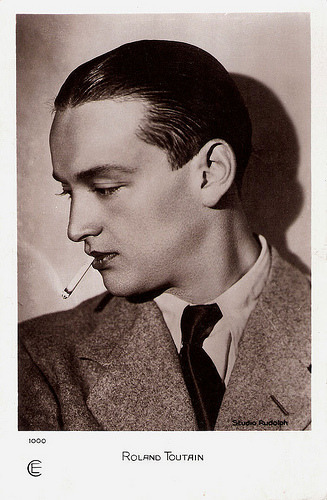
French postcard by Cinémagazine-Selection, Paris, no. 1000. Photo: Studio Rudolph.
Daredevil Air Stunts
Roland Toutain was born in Paris in 1905. He was the son of a horse breeder from Normandy, and a fearless artist from Corsica. When he was two, his father liked to throw him in lake Vésinet, thinking he would learn to swim naturally that way.
As a teenager Toutain climbed the Eiffel Tower and loved to do acrobatics on cars and trains. He spent a lot of time on airports, so it was logical he was going to do aerial stunts.
The cinema attracted the young stuntman, who was an admirer of American film star Douglas Fairbanks. After meeting director Marcel L’Herbier, he played some small parts in the silent films La Galerie des monstres/Gallery of Monsters ( Jaque Catelain , 1923) and L'Inhumaine (Marcel L'Herbier, 1924).
He first gained fame in the crime film Le mystère de la chambre jaune/The Mystery of the Yellow Room (Marcel L’Herbier, 1930) based on one of the first locked room mystery crime fiction novels, written by Gaston Leroux. Toutain was perfectly cast as the youthful journalist Joseph Rouletabille, Leroux's equivalent of Hercule Poirot or Sherlock Holmes.
Toutain returned in the sequel Le parfum de la dame en noir/The Perfume of the Lady in Black Room (Marcel L’Herbier, 1930), in fact one long story divided into two episodes. Later he reprised the role in Rouletabille aviateur/Flying Gold (Steve Sekely, 1932).
Toutain had a supporting role in Fritz Lang’s only French film, the fantasy Liliom (1934) starring Charles Boyer and Madeleine Ozeray.
He served as a foil to romantic young leads like Jean-Pierre Aumont in L'équipage/Flight Into Darkness (Anatole Litvak, 1935) and La porte du large/The Great Temptation (Marcel L'Herbier, 1936).
In 1937, he appeared in the French drama Yoshiwara (Max Ophüls, 1937) starring Pierre Richard-Willm , Sessue Hayakawa and Michiko Tanaka. The film is set in the Yoshiwara, the red-light district of Tokyo, in the nineteenth century.
His best known role is the aviator André Jurieux in the a satire of the upper-middle classes La Règle du jeu/The Rules of the Game (Jean Renoir, 1939). The film capitalized on stories in fan magazines about Toutain’s daredevil air stunts and his reckless personality.
In the film, the French aviation hero has fallen in love with Christine de la Chesnaye ( Nora Gregor ), who is married to wealthy aristocrat Marquis Robert de la Chesnaye ( Marcel Dalio ). Renoir’s classic comedy of manners contrasts the romantic entanglements of rich and poor during a a weekend hunting party at the country estate.
In the 1930s Toutain was befriended with boxer Al Brown and together they would often hit the nightclubs of Montmartre.
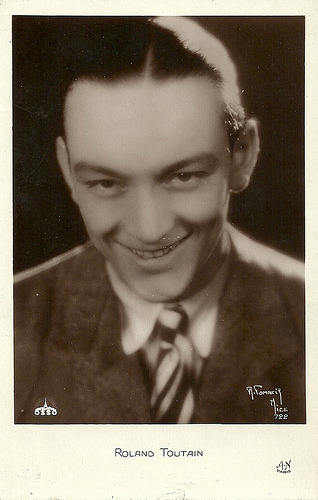
French postcard by A.N., Paris, no. 722. Photo R. Tomarif [?], Nice / Osso. Could be a publicity still for the film Le mystère de la chambre jaune (Marcel L'Herbier, 1930).
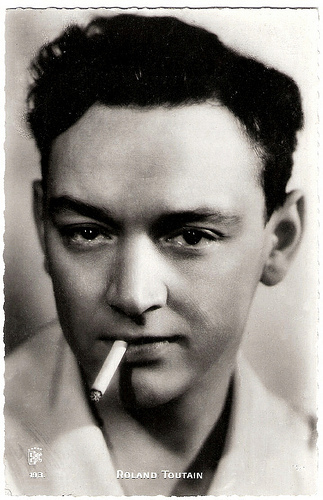
French postcard by EPC, no. 193.
Les quatre cents coups
During the 1940s, Roland Toutain played the seductive charmer in several interesting adventure films. He appeared as Scapin in Le capitaine Fracasse/Captain Fracasse ( Abel Gance , 1942) with Fernand Gravey , and played a garage owner in the box office hit L'Éternel retour/The Eternal Return (Jean Delannoy, 1943), written by Jean Cocteau, and starring Madeleine Sologne and Jean Marais .
Then he was Cabrion, in Les Mystères de Paris/The Mysteries of Paris (Jacques de Baroncelli, 1943). He reunited with Marcel L’Herbier for La vie de bohème (Marcel L’Herbier, 1945) starring María Dénis and Louis Jourdan .
In his films he jumped off a moving train into a river and did trapeze stunts under a flying airplane. In 1949, he founded the Club des Casse-cou (Club Daredevil), bringing together the famous stuntmen of the time, including specialist Gil Delamare who died in 1966 during the filming of Le Saint prend l'Affût.
In 1951, Toutain had an accident for the umpteenth time and one of his legs had to be amputated. Still in his final film, L'inspecteur aime la bagarre/The inspector likes to fight (Jean-Devaivre, 1956), he did some amazing stunts.
After his retirement he spent his time generously for La roue tourne, an association dedicated to needy actors. He lived with his mother in Argenteuil, where he died in poverty in 1977, at the age of 71.
His good friend Jean Marais organized his funeral. Toutain lies buried in Argentueil, with a miniature of a stuntman on top of a plane on his grave.
Roland Toutain married and divorced three times. With his girlfriend Odette Calais, he had a son: actor Jacques Maire, whom he never recognized, despite mediation by Jean Marais .
In 1951 he published his souvenirs as Les quatre cents coups, with prefaces by Jean Cocteau and Joseph Kessel. In French 'faire les 400 coups' means committing all the possible stupidities. Les quatre cents coups/The 400 blows 1959) is also the title of a famous film by François Truffaut.
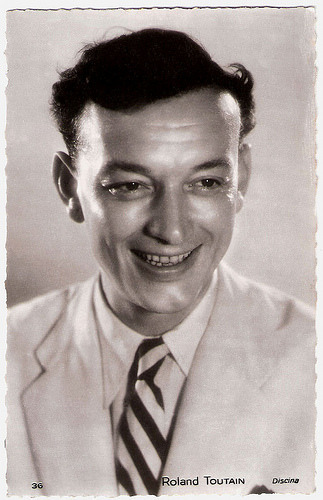
French postcard by Editions EC, no. 36. Photo: Discina.
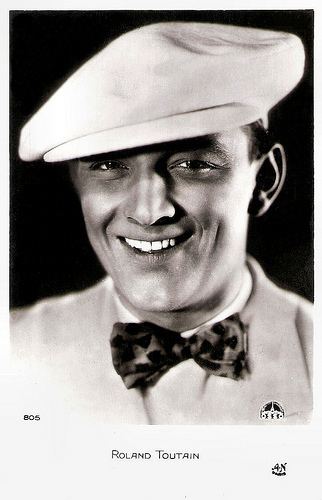
French postcard by A.N., Paris, no. 805. Photo: Osso Films. Publicity still for Rouletabille aviateur (Steve Szekely, 1932).
Sources: Wikipedia (French) and .

French postcard by Cinémagazine-Selection, Paris, no. 1000. Photo: Studio Rudolph.
Daredevil Air Stunts
Roland Toutain was born in Paris in 1905. He was the son of a horse breeder from Normandy, and a fearless artist from Corsica. When he was two, his father liked to throw him in lake Vésinet, thinking he would learn to swim naturally that way.
As a teenager Toutain climbed the Eiffel Tower and loved to do acrobatics on cars and trains. He spent a lot of time on airports, so it was logical he was going to do aerial stunts.
The cinema attracted the young stuntman, who was an admirer of American film star Douglas Fairbanks. After meeting director Marcel L’Herbier, he played some small parts in the silent films La Galerie des monstres/Gallery of Monsters ( Jaque Catelain , 1923) and L'Inhumaine (Marcel L'Herbier, 1924).
He first gained fame in the crime film Le mystère de la chambre jaune/The Mystery of the Yellow Room (Marcel L’Herbier, 1930) based on one of the first locked room mystery crime fiction novels, written by Gaston Leroux. Toutain was perfectly cast as the youthful journalist Joseph Rouletabille, Leroux's equivalent of Hercule Poirot or Sherlock Holmes.
Toutain returned in the sequel Le parfum de la dame en noir/The Perfume of the Lady in Black Room (Marcel L’Herbier, 1930), in fact one long story divided into two episodes. Later he reprised the role in Rouletabille aviateur/Flying Gold (Steve Sekely, 1932).
Toutain had a supporting role in Fritz Lang’s only French film, the fantasy Liliom (1934) starring Charles Boyer and Madeleine Ozeray.
He served as a foil to romantic young leads like Jean-Pierre Aumont in L'équipage/Flight Into Darkness (Anatole Litvak, 1935) and La porte du large/The Great Temptation (Marcel L'Herbier, 1936).
In 1937, he appeared in the French drama Yoshiwara (Max Ophüls, 1937) starring Pierre Richard-Willm , Sessue Hayakawa and Michiko Tanaka. The film is set in the Yoshiwara, the red-light district of Tokyo, in the nineteenth century.
His best known role is the aviator André Jurieux in the a satire of the upper-middle classes La Règle du jeu/The Rules of the Game (Jean Renoir, 1939). The film capitalized on stories in fan magazines about Toutain’s daredevil air stunts and his reckless personality.
In the film, the French aviation hero has fallen in love with Christine de la Chesnaye ( Nora Gregor ), who is married to wealthy aristocrat Marquis Robert de la Chesnaye ( Marcel Dalio ). Renoir’s classic comedy of manners contrasts the romantic entanglements of rich and poor during a a weekend hunting party at the country estate.
In the 1930s Toutain was befriended with boxer Al Brown and together they would often hit the nightclubs of Montmartre.

French postcard by A.N., Paris, no. 722. Photo R. Tomarif [?], Nice / Osso. Could be a publicity still for the film Le mystère de la chambre jaune (Marcel L'Herbier, 1930).

French postcard by EPC, no. 193.
Les quatre cents coups
During the 1940s, Roland Toutain played the seductive charmer in several interesting adventure films. He appeared as Scapin in Le capitaine Fracasse/Captain Fracasse ( Abel Gance , 1942) with Fernand Gravey , and played a garage owner in the box office hit L'Éternel retour/The Eternal Return (Jean Delannoy, 1943), written by Jean Cocteau, and starring Madeleine Sologne and Jean Marais .
Then he was Cabrion, in Les Mystères de Paris/The Mysteries of Paris (Jacques de Baroncelli, 1943). He reunited with Marcel L’Herbier for La vie de bohème (Marcel L’Herbier, 1945) starring María Dénis and Louis Jourdan .
In his films he jumped off a moving train into a river and did trapeze stunts under a flying airplane. In 1949, he founded the Club des Casse-cou (Club Daredevil), bringing together the famous stuntmen of the time, including specialist Gil Delamare who died in 1966 during the filming of Le Saint prend l'Affût.
In 1951, Toutain had an accident for the umpteenth time and one of his legs had to be amputated. Still in his final film, L'inspecteur aime la bagarre/The inspector likes to fight (Jean-Devaivre, 1956), he did some amazing stunts.
After his retirement he spent his time generously for La roue tourne, an association dedicated to needy actors. He lived with his mother in Argenteuil, where he died in poverty in 1977, at the age of 71.
His good friend Jean Marais organized his funeral. Toutain lies buried in Argentueil, with a miniature of a stuntman on top of a plane on his grave.
Roland Toutain married and divorced three times. With his girlfriend Odette Calais, he had a son: actor Jacques Maire, whom he never recognized, despite mediation by Jean Marais .
In 1951 he published his souvenirs as Les quatre cents coups, with prefaces by Jean Cocteau and Joseph Kessel. In French 'faire les 400 coups' means committing all the possible stupidities. Les quatre cents coups/The 400 blows 1959) is also the title of a famous film by François Truffaut.

French postcard by Editions EC, no. 36. Photo: Discina.

French postcard by A.N., Paris, no. 805. Photo: Osso Films. Publicity still for Rouletabille aviateur (Steve Szekely, 1932).
Sources: Wikipedia (French) and .
Published on April 20, 2014 23:00
April 19, 2014
Golgotha (1935)
Happy Easter! Today, a post on the French film
Golgotha/Ecce Homo
(Julien Duvivier, 1935), an ambitious and expensive retelling of the Last Days of Jesus Christ.
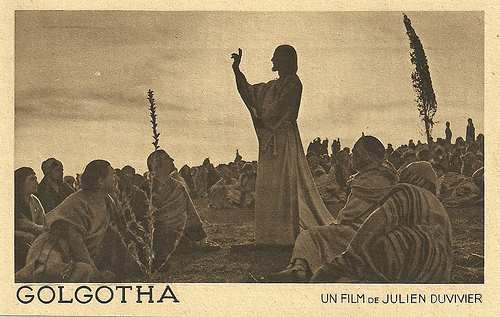
French postcard.
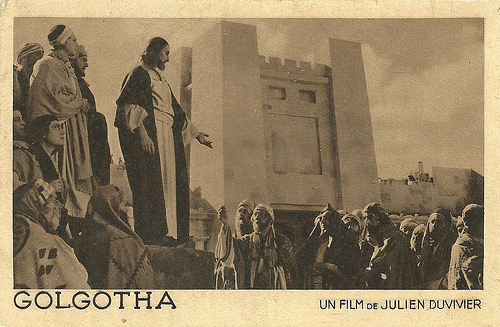
French postcard.
The Son Of God
In Golgotha Robert Le Vigan plays the Son of God. His performance marks the first direct portrayal of Christ in a sound film.
The film covers Palm Sunday, the Passion, and the Resurrection. All of Jesus' dialogue is taken directly from the Scriptures, with no film-style adornments. Hal Erickson notes at AllMovie that Le Vigan delivers these lines with sincerity and quiet grace.
Hal Erickson: "Considering the anti-Semitism prevalent in Europe during the 1930s, the question of the Jews' responsibility for Jesus' death is handled with restraint; blame is squarely laid on the shoulders of a handful of conspirators, rather than an entire race.
For the most part, Jesus is shown from a respectful distance as was also the case in Ben-Hur, Quo Vadis, or The Robe, but there are also a few closer shots and even close-ups.
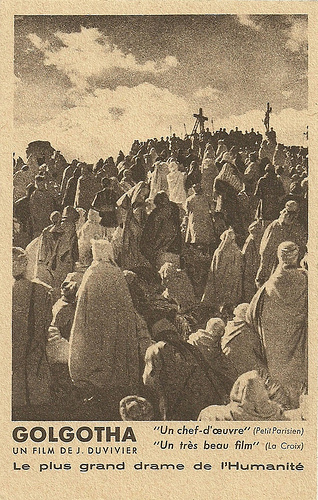
French postcard.
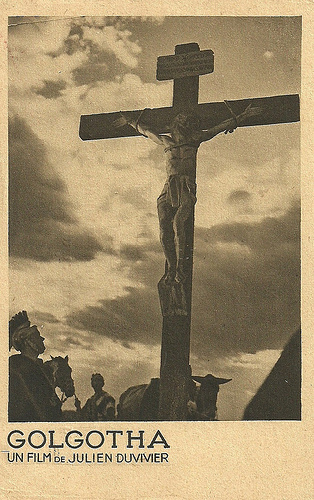
French postcard.
Almost Lost in the Shuffle
Kevin C. Neece at Jesus Films 101 : "Le Vigan holds his own in the role, presenting a more stoic Christ, unmoved by the circumstances around him. But, in a film of passionate performances and engaging cinematography, Le Vigan’s performance almost gets lost in the shuffle."
Golgotha also stars Harry Baur as Herod, Jean Gabin as Pontius Pilate and Edwige Feuillère as Claudia Procula. The cast list in the opening credits is read out by an off-screen voice.
Golgotha was directed by Julien Duvivier, who had made several religious films during the silent era. The score was composed by French composer Jacques Ibert.
Golgotha played throughout Europe, but the British Board of Film Censors "would not allow British eyes to see it." The film opened in the US in 1937. The National Board of Review named the film the sixth best foreign film of 1937.
dbdumonteil at IMDb : "the cinematography is wonderful; two examples: the three crosses, climbing up the Golgotha, or Judas's death, seen from a distance. Aerial pictures of Jerusalem already display Duvivier's sense of space which will be used to even better effects in his celebrated Pepe le Moko. The movements in the crowd compare favourably with the best of the epics of those ancient times such as Fred Niblo's Ben Hur (1925). The forty lashes scene, which the populace intently watches behind the bars, is not out of place in a Duvivier movie: nobody in France depicted human wickedness like he did."
And finally Kevin C. Neece: "Golgotha is an intelligent, engaging and excellently executed film. Though Le Vigan’s Christ is perhaps too distant, too lacking in humanity and dimension, the film overall teems with sweaty, complex humanity and seems to set the tone for many Jesus films that would follow."
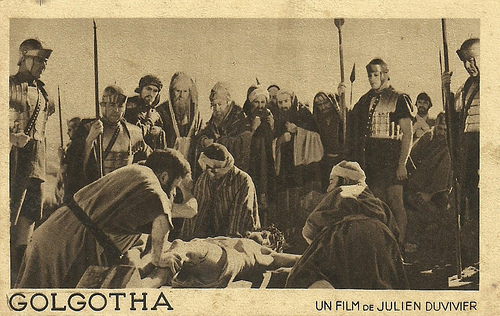
French postcard.
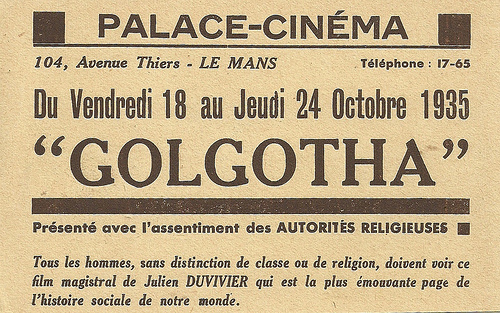
French postcard. From Friday 18 to Thursday 24 October 1935 at the Palace-Cinéma, Avenue Thiers 104, Le Mans, France. 'Shown with the consent of the religious authorities.'
Sources: Kevin C. Neece (Jesus Films 101), Hal Erickson (AllMovie), dbdumonteil (IMDb), Wikipedia and IMDb.

French postcard.

French postcard.
The Son Of God
In Golgotha Robert Le Vigan plays the Son of God. His performance marks the first direct portrayal of Christ in a sound film.
The film covers Palm Sunday, the Passion, and the Resurrection. All of Jesus' dialogue is taken directly from the Scriptures, with no film-style adornments. Hal Erickson notes at AllMovie that Le Vigan delivers these lines with sincerity and quiet grace.
Hal Erickson: "Considering the anti-Semitism prevalent in Europe during the 1930s, the question of the Jews' responsibility for Jesus' death is handled with restraint; blame is squarely laid on the shoulders of a handful of conspirators, rather than an entire race.
For the most part, Jesus is shown from a respectful distance as was also the case in Ben-Hur, Quo Vadis, or The Robe, but there are also a few closer shots and even close-ups.

French postcard.

French postcard.
Almost Lost in the Shuffle
Kevin C. Neece at Jesus Films 101 : "Le Vigan holds his own in the role, presenting a more stoic Christ, unmoved by the circumstances around him. But, in a film of passionate performances and engaging cinematography, Le Vigan’s performance almost gets lost in the shuffle."
Golgotha also stars Harry Baur as Herod, Jean Gabin as Pontius Pilate and Edwige Feuillère as Claudia Procula. The cast list in the opening credits is read out by an off-screen voice.
Golgotha was directed by Julien Duvivier, who had made several religious films during the silent era. The score was composed by French composer Jacques Ibert.
Golgotha played throughout Europe, but the British Board of Film Censors "would not allow British eyes to see it." The film opened in the US in 1937. The National Board of Review named the film the sixth best foreign film of 1937.
dbdumonteil at IMDb : "the cinematography is wonderful; two examples: the three crosses, climbing up the Golgotha, or Judas's death, seen from a distance. Aerial pictures of Jerusalem already display Duvivier's sense of space which will be used to even better effects in his celebrated Pepe le Moko. The movements in the crowd compare favourably with the best of the epics of those ancient times such as Fred Niblo's Ben Hur (1925). The forty lashes scene, which the populace intently watches behind the bars, is not out of place in a Duvivier movie: nobody in France depicted human wickedness like he did."
And finally Kevin C. Neece: "Golgotha is an intelligent, engaging and excellently executed film. Though Le Vigan’s Christ is perhaps too distant, too lacking in humanity and dimension, the film overall teems with sweaty, complex humanity and seems to set the tone for many Jesus films that would follow."

French postcard.

French postcard. From Friday 18 to Thursday 24 October 1935 at the Palace-Cinéma, Avenue Thiers 104, Le Mans, France. 'Shown with the consent of the religious authorities.'
Sources: Kevin C. Neece (Jesus Films 101), Hal Erickson (AllMovie), dbdumonteil (IMDb), Wikipedia and IMDb.
Published on April 19, 2014 23:00
April 18, 2014
Marie Versini
French film star Marie Versini (1940) is best known of the Karl May Westerns as Winnetou’s sister. The lovely, beguiling, dark-haired actress had an international film career in the late 1950s and 1960s.
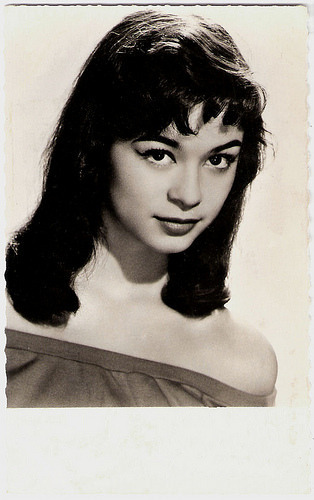
French postcard by Editions P.I., no. 899. Photo: Lucienne Chevert.
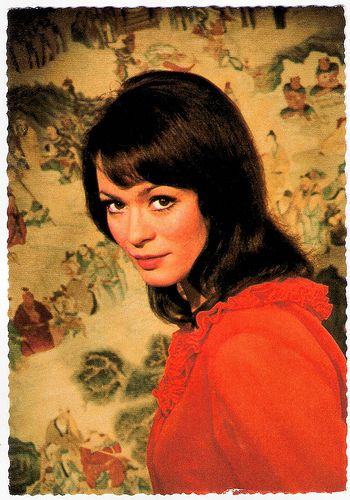
German postcard by ISV, no. E 35. Photo: Constantin. Publicity still for The Brides of Fu Manchu (Don Sharp, 1966).
The Love Interest of Sean Flynn
Marie Versini was born in Paris, France, in 1940. She was the daughter of a grammar school teacher.
In 1954 she started to follow classes at the Conservatoire National d’Art Dramatique. Her film career started at the age of 16 with a bit role in Mitsou (Jacqueline Audry, 1956), based on the novel by Colette.
In 1957 she became the youngest company member of the Comédie Française in Paris. She would play roles in the plays of Moliére, Jean Racine, Beaumarchais, Victor Hugo, and William Shakespeare.
Her film debut was followed by parts in the British Charles Dickens adaptation A Tale of Two Cities (Ralph Thomas, 1958) with Dirk Bogarde , and the French TV-film Britannicus (Jean Kerchbron, 1959) based on the play by Jean Racine.
She played at Eddie Constantine 's side in the gangster film Chien de pique/Jack of Spades (Yves Allégret, 1960).
She also appeared in the American productions Paris Blues (Martin Ritt, 1961) with Paul Newman, and in Roger Corman's actioner The Young Racers (1963) with Mark Damon.
In Italy, she was the love interest of Sean Flynn, the son of Errol Flynn and Lily Damita , in the adventure film Sandokan, la Tigre di Mompracem/Temple of the White Elephant (Umberto Lenzi, 1963).
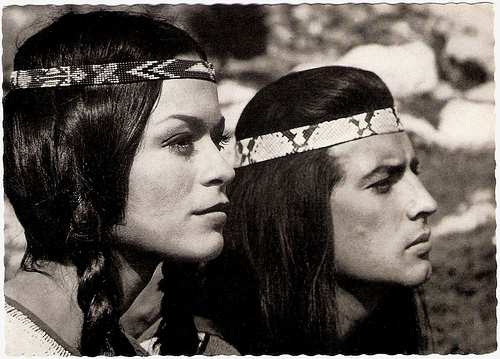
German postcard by Filmbilder-Vertrieb Ernst Freihoff, Essen, no. 892. Retail price: 10 Pfg. Photo: Rialto / Constantin / Kran. Still from one of the Winnetou films with Marie Versini and Pierre Brice.
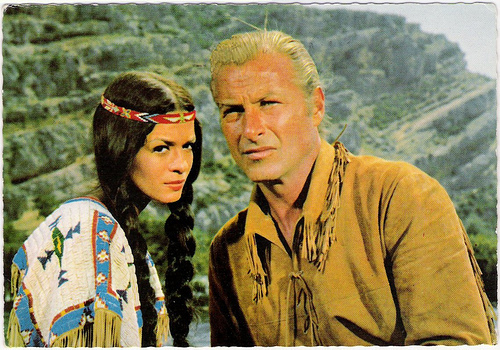
German postcard, no. E 30. Photo: still from one of the Winnetou films with Marie Versini and Lex Barker.
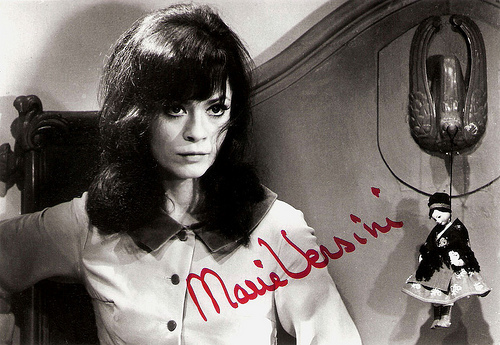
German card by Marie-Versini-Club. Photo: publicity still for Ferien mit Piroschka/Piroschka (Franz Josef Gottlieb, 1965).
Winnetou’s sister
Marie Versini's breakthrough came in the German/French/Yugoslav coproduction Winnetou I. Teil/Apache Gold (Harald Reinl, 1963). This was a film in a series of European Technicolor Westerns based on the Winnetou-stories of German author Karl May.
As in most of these films, French actor Pierre Brice starred as the brave Indian Winnetou, and former Hollywood Tarzan Lex Barker co-starred as his loyal friend Old Shatterhand.
Marie Versini played Winnetou’s sister Nscho-tschi, who also became friends with Old Shatterhand. With this role she became – overnight - tremendously popular in Germany.
She would appear in four more Karl May adventures: Der Schut/The Shoot (Robert Siodmak, 1964), Durchs wilde Kurdistan/Wild Kurdistan (Franz Josef Gottlieb, 1965), Im Reich des silbernen Löwen/Attack of the Kurds (Franz Josef Gottlieb, 1965) and Winnetou und sein Freund Old Firehand/Thunder at the Border (Alfred Vohrer, 1966).
Besides the Karl May films she also took part in the popular German productions Kennwort...Reiher/The River Line (Rudolf Jugert, 1964) and Liebesnächte in der Taiga/Code Name Kill (Harald Philipp, 1967), and in the French war film Paris brûle-t-il?/Is Paris Burning? (René Clément, 1966) with Jean-Paul Belmondo .
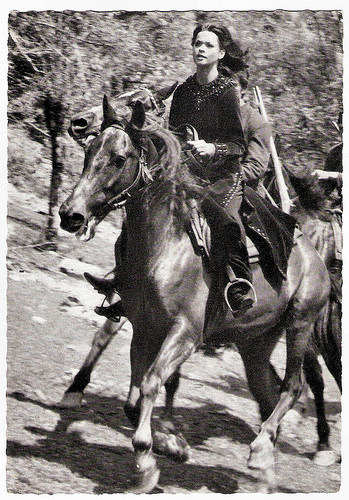
German postcard by Filmbilder-Vertrieb Ernst Freihoff, Essen, no. 921. Retail price: 10 Pfg. Photo: Gloria / Schnelle. Publicity still for Der Schut/The Shoot (Robert Siodmak, 1964).
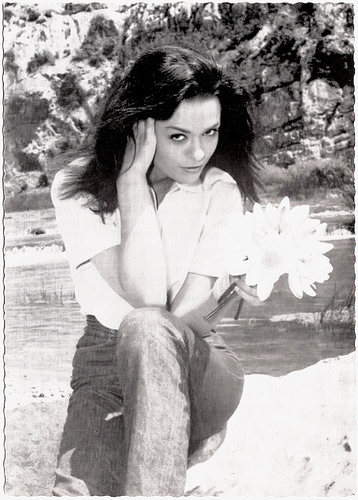
German postcard by Ernst Freihoff, Essen. Photo: Lothar Winkler.
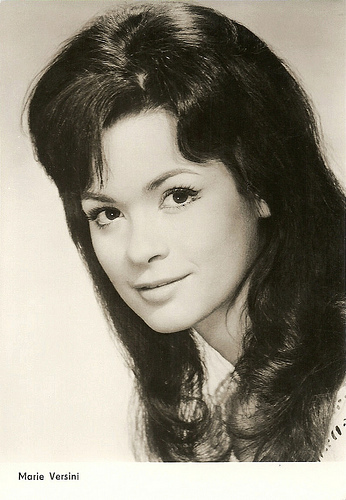
East-German card by VEB Progress Film-Vertrieb. Collection: Didier Hanson.
Winnetou May Not Die
In the 1970s her activity in front of the film cameras diminished, but she was regularly seen in TV productions.
To her later work belong an episode of the serial Paul Temple: Antique Death (1970), Der Lift/The Elevator (Georg Tressler, 1972), Pour une poignée d'herbes sauages (1973), an episode of the serial Arsène Lupin: Le film révélateur (1974), the serial Die Pawlaks/The Pawlaks (Wolfgang Staudte, 1982) and the serial Die schöne Wilhelmine/The Beautiful Wilhelmine (1984).
In 2007 she returned to the screen in the documentary Winnetou darf nicht sterben/Winnetou May Not Die (Oliver Schwehm, 2007), a portrait of Pierre Brice .
Marie Versini published two books: her memoirs Ich war Winnetous Schwester/I Was Winnetou’s Sister (2003), and the Western novel Rätsel um N.T/ Mysteries Around N.T. (2008).
In 1974 Marie Versini married author and director Pierre Viallet, with whom she often cooperated. He passed away in 2013.
Trailer of Winnetou I. Teil/Apache Gold (1963). Source: RialtoFilm (YouTube).
Jean-Paul Belmondo fights the Nazi invasion of Paris with the help of Marie Versini in Paris brûle-t-il?/Is Paris Burning? (1966). Source: Mondobelmondo (YouTube).
Source: marie-versini.de, Thomas Staedeli (Cyranos), AllMovie, Wikipedia (German) and .

French postcard by Editions P.I., no. 899. Photo: Lucienne Chevert.

German postcard by ISV, no. E 35. Photo: Constantin. Publicity still for The Brides of Fu Manchu (Don Sharp, 1966).
The Love Interest of Sean Flynn
Marie Versini was born in Paris, France, in 1940. She was the daughter of a grammar school teacher.
In 1954 she started to follow classes at the Conservatoire National d’Art Dramatique. Her film career started at the age of 16 with a bit role in Mitsou (Jacqueline Audry, 1956), based on the novel by Colette.
In 1957 she became the youngest company member of the Comédie Française in Paris. She would play roles in the plays of Moliére, Jean Racine, Beaumarchais, Victor Hugo, and William Shakespeare.
Her film debut was followed by parts in the British Charles Dickens adaptation A Tale of Two Cities (Ralph Thomas, 1958) with Dirk Bogarde , and the French TV-film Britannicus (Jean Kerchbron, 1959) based on the play by Jean Racine.
She played at Eddie Constantine 's side in the gangster film Chien de pique/Jack of Spades (Yves Allégret, 1960).
She also appeared in the American productions Paris Blues (Martin Ritt, 1961) with Paul Newman, and in Roger Corman's actioner The Young Racers (1963) with Mark Damon.
In Italy, she was the love interest of Sean Flynn, the son of Errol Flynn and Lily Damita , in the adventure film Sandokan, la Tigre di Mompracem/Temple of the White Elephant (Umberto Lenzi, 1963).

German postcard by Filmbilder-Vertrieb Ernst Freihoff, Essen, no. 892. Retail price: 10 Pfg. Photo: Rialto / Constantin / Kran. Still from one of the Winnetou films with Marie Versini and Pierre Brice.

German postcard, no. E 30. Photo: still from one of the Winnetou films with Marie Versini and Lex Barker.

German card by Marie-Versini-Club. Photo: publicity still for Ferien mit Piroschka/Piroschka (Franz Josef Gottlieb, 1965).
Winnetou’s sister
Marie Versini's breakthrough came in the German/French/Yugoslav coproduction Winnetou I. Teil/Apache Gold (Harald Reinl, 1963). This was a film in a series of European Technicolor Westerns based on the Winnetou-stories of German author Karl May.
As in most of these films, French actor Pierre Brice starred as the brave Indian Winnetou, and former Hollywood Tarzan Lex Barker co-starred as his loyal friend Old Shatterhand.
Marie Versini played Winnetou’s sister Nscho-tschi, who also became friends with Old Shatterhand. With this role she became – overnight - tremendously popular in Germany.
She would appear in four more Karl May adventures: Der Schut/The Shoot (Robert Siodmak, 1964), Durchs wilde Kurdistan/Wild Kurdistan (Franz Josef Gottlieb, 1965), Im Reich des silbernen Löwen/Attack of the Kurds (Franz Josef Gottlieb, 1965) and Winnetou und sein Freund Old Firehand/Thunder at the Border (Alfred Vohrer, 1966).
Besides the Karl May films she also took part in the popular German productions Kennwort...Reiher/The River Line (Rudolf Jugert, 1964) and Liebesnächte in der Taiga/Code Name Kill (Harald Philipp, 1967), and in the French war film Paris brûle-t-il?/Is Paris Burning? (René Clément, 1966) with Jean-Paul Belmondo .

German postcard by Filmbilder-Vertrieb Ernst Freihoff, Essen, no. 921. Retail price: 10 Pfg. Photo: Gloria / Schnelle. Publicity still for Der Schut/The Shoot (Robert Siodmak, 1964).

German postcard by Ernst Freihoff, Essen. Photo: Lothar Winkler.

East-German card by VEB Progress Film-Vertrieb. Collection: Didier Hanson.
Winnetou May Not Die
In the 1970s her activity in front of the film cameras diminished, but she was regularly seen in TV productions.
To her later work belong an episode of the serial Paul Temple: Antique Death (1970), Der Lift/The Elevator (Georg Tressler, 1972), Pour une poignée d'herbes sauages (1973), an episode of the serial Arsène Lupin: Le film révélateur (1974), the serial Die Pawlaks/The Pawlaks (Wolfgang Staudte, 1982) and the serial Die schöne Wilhelmine/The Beautiful Wilhelmine (1984).
In 2007 she returned to the screen in the documentary Winnetou darf nicht sterben/Winnetou May Not Die (Oliver Schwehm, 2007), a portrait of Pierre Brice .
Marie Versini published two books: her memoirs Ich war Winnetous Schwester/I Was Winnetou’s Sister (2003), and the Western novel Rätsel um N.T/ Mysteries Around N.T. (2008).
In 1974 Marie Versini married author and director Pierre Viallet, with whom she often cooperated. He passed away in 2013.
Trailer of Winnetou I. Teil/Apache Gold (1963). Source: RialtoFilm (YouTube).
Jean-Paul Belmondo fights the Nazi invasion of Paris with the help of Marie Versini in Paris brûle-t-il?/Is Paris Burning? (1966). Source: Mondobelmondo (YouTube).
Source: marie-versini.de, Thomas Staedeli (Cyranos), AllMovie, Wikipedia (German) and .
Published on April 18, 2014 23:00
April 17, 2014
Lyda Salmonova
Czech stage and film actress Lyda Salmonova (1889–1968) was married to German actor Paul Wegener and appeared with him in silent horror classics like Der Student von Prag/The Student of Prague (1913) and Der Golem (1915 and 1920).
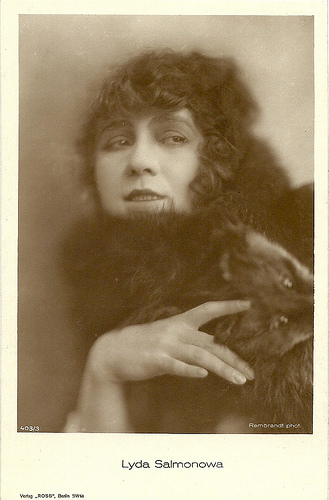
German postcard by Ross Verlag, no. 403/3, 1919-1924. Photo: Rembrandt phot. Collection: Didier Hanson.
Silent Horror
Lyda Salmonova (in Germany written as Salmonowa) was born in Prague, Austria-Hungary (now Czech Republic) in 1889. As a girl she took dance classes.
In 1909, she moved to Berlin where she studied acting at the school of the Deutschen Theater. Soon manager-director Max Reinhardt offered her a role. She played a supporting part in the pantomime Sumurun and also played in Der Totentanz by August Strindberg.
One of her first parts in the cinema was the flower girl Lyduschka in the German silent horror film Der Student von Prag/The Student of Prague (Stellan Rye, Paul Wegener , 1913) generally deemed to be the first independent film in history.
Balduin, a poor student ( Paul Wegener ) rescues a beautiful countess (Grete Berger) and soon becomes obsessed with her. A sorcerer makes a deal with the young man to give him fabulous wealth and anything he wants, if he will sign his name to a contract. The student hurriedly signs the contract, but doesn't know what he's in for.
The film was remade in 1926, under the same title Der Student von Prag/The Student of Prague. Other remakes were produced in 1935 and 2004.
Salmonova and Wegener married in 1913 and would costar in 15 films.
In 1915, she appeared with Wegener in the silent horror film Der Golem/The Monster of Fate, written and directed by Paul Wegener and Henrik Galeen.
The film is inspired by ancient Jewish legend about the golem, a clay statue brought to life by Rabbi Loew in 16th century Prague to save the Jews from the on-going brutal persecution by the city's rulers.
Der Golem is the first of a trilogy by Wegener, followed by the short comedy Der Golem und die Tänzerin/The Golem and the Dancing Girl ( Paul Wegener , Rochus Gliese, 1917) and Der Golem, wie er in die Welt kam/The Golem: How He Came into the World (Carl Boese, Paul Wegener , 1920). In all three films Salmonova played the female lead.
She probably was also in the cast of the horror film Der Bucklige und die Tänzerin/The Hunchback and the Dancer (1920) directed by F. W. Murnau, but the film is considered to be lost.
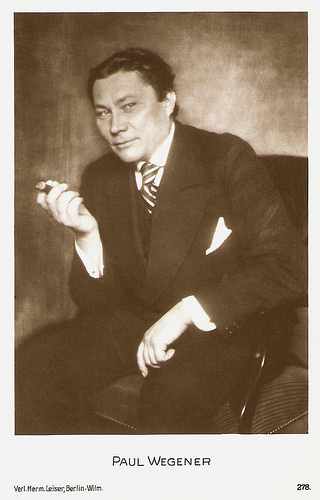
Paul Wegener . German postcard by Verlag Hermann Leiser, Berlin-Wilh., no. 278.
Wandering Souls
During the early 1920s, Lyda Salmonova appeared in silent films like the adventure film Brennendes Land/Burning Country (Heinz Herald, 1921) starring Marie Wismar, Ernst Deutsch and Kurt Vespermann . She also played a supporting part in the drama Irrende Seelen/Wandering Souls (Carl Froelich, 1921) starring Asta Nielsen , and based on the novel The Idiot by Fyodor Dostoyevsky.
She also appeared in the historical epic Das Weib des Pharao/The Loves of Pharaoh ( Ernst Lubitsch , 1922) starring Emil Jannings . A complete version of the film had been considered lost for years, but in 2011 a digitally restored and reconstructed version premièred including the original music by composer Eduard Künneke that had been commissioned for the film by Lubitsch. The Loves of Pharaoh was Lubitsch last German feature before he migrated to Hollywood in 1923.
Salmonova also had a part in the silent historic film Lucrezia Borgia/Lucretia Borgia (Richard Oswald, 1922) featuring Liane Haid .
Her biggest roles were in the films by her husband Paul Wegener . One of their last collaborations was Herzog Ferrantes Ende/Duke Ferrantes End ( Paul Wegener , Rochus Gliese, 1922). Her last film was S.O S. Die Insel der Tränen/S.O.S. The island of tears (Lothar Mendes, 1923), as the wife of Paul Wegener .
In 1923 the two divorced and Lyda Salmonova’s film career stopped. She only performed on stage till the early 1930s. She started to work as an acting teacher. She worked at the Ufa film school in Potsdam-Babelsberg and under the name of Lyda Wegener she started her own theatre school.
During the war years she lived in Berlin and was bombed there several times. After the war, she returned to her birthplace Prague. Lyda Salmonova died in 1968 in Prague. She was 79.
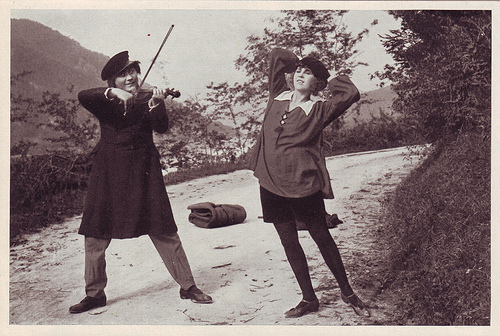
Paul Wegener and Lyda Salmonova. German collectors card by Cigaretten Bilderdienst Altona-Bahrenfeld, no. 133 (Vom Werden deutscher Filmkunst. Der Stümme Film). Collection: Manuel Palomino Arjona.
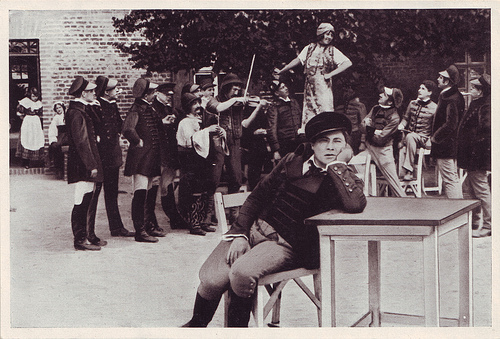
Paul Wegener and Lyda Salmonova. German collectors card by Cigaretten Bilderdienst Altona-Bahrenfeld, no. 9 (Vom Werden deutscher Filmkunst. Der Stümme Film). Collection: Manuel Palomino Arjona.
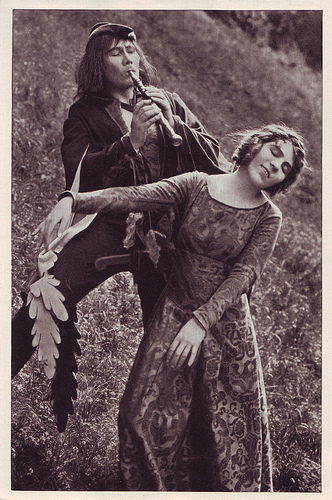
Paul Wegener and Lyda Salmonova. German collectors card by Cigaretten Bilderdienst Altona-Bahrenfeld, no. 86 (Vom Werden deutscher Filmkunst. Der Stümme Film). Collection: Manuel Palomino Arjona.
Sources: Film Zeit.de (German), Wikipedia (German and English), and .

German postcard by Ross Verlag, no. 403/3, 1919-1924. Photo: Rembrandt phot. Collection: Didier Hanson.
Silent Horror
Lyda Salmonova (in Germany written as Salmonowa) was born in Prague, Austria-Hungary (now Czech Republic) in 1889. As a girl she took dance classes.
In 1909, she moved to Berlin where she studied acting at the school of the Deutschen Theater. Soon manager-director Max Reinhardt offered her a role. She played a supporting part in the pantomime Sumurun and also played in Der Totentanz by August Strindberg.
One of her first parts in the cinema was the flower girl Lyduschka in the German silent horror film Der Student von Prag/The Student of Prague (Stellan Rye, Paul Wegener , 1913) generally deemed to be the first independent film in history.
Balduin, a poor student ( Paul Wegener ) rescues a beautiful countess (Grete Berger) and soon becomes obsessed with her. A sorcerer makes a deal with the young man to give him fabulous wealth and anything he wants, if he will sign his name to a contract. The student hurriedly signs the contract, but doesn't know what he's in for.
The film was remade in 1926, under the same title Der Student von Prag/The Student of Prague. Other remakes were produced in 1935 and 2004.
Salmonova and Wegener married in 1913 and would costar in 15 films.
In 1915, she appeared with Wegener in the silent horror film Der Golem/The Monster of Fate, written and directed by Paul Wegener and Henrik Galeen.
The film is inspired by ancient Jewish legend about the golem, a clay statue brought to life by Rabbi Loew in 16th century Prague to save the Jews from the on-going brutal persecution by the city's rulers.
Der Golem is the first of a trilogy by Wegener, followed by the short comedy Der Golem und die Tänzerin/The Golem and the Dancing Girl ( Paul Wegener , Rochus Gliese, 1917) and Der Golem, wie er in die Welt kam/The Golem: How He Came into the World (Carl Boese, Paul Wegener , 1920). In all three films Salmonova played the female lead.
She probably was also in the cast of the horror film Der Bucklige und die Tänzerin/The Hunchback and the Dancer (1920) directed by F. W. Murnau, but the film is considered to be lost.

Paul Wegener . German postcard by Verlag Hermann Leiser, Berlin-Wilh., no. 278.
Wandering Souls
During the early 1920s, Lyda Salmonova appeared in silent films like the adventure film Brennendes Land/Burning Country (Heinz Herald, 1921) starring Marie Wismar, Ernst Deutsch and Kurt Vespermann . She also played a supporting part in the drama Irrende Seelen/Wandering Souls (Carl Froelich, 1921) starring Asta Nielsen , and based on the novel The Idiot by Fyodor Dostoyevsky.
She also appeared in the historical epic Das Weib des Pharao/The Loves of Pharaoh ( Ernst Lubitsch , 1922) starring Emil Jannings . A complete version of the film had been considered lost for years, but in 2011 a digitally restored and reconstructed version premièred including the original music by composer Eduard Künneke that had been commissioned for the film by Lubitsch. The Loves of Pharaoh was Lubitsch last German feature before he migrated to Hollywood in 1923.
Salmonova also had a part in the silent historic film Lucrezia Borgia/Lucretia Borgia (Richard Oswald, 1922) featuring Liane Haid .
Her biggest roles were in the films by her husband Paul Wegener . One of their last collaborations was Herzog Ferrantes Ende/Duke Ferrantes End ( Paul Wegener , Rochus Gliese, 1922). Her last film was S.O S. Die Insel der Tränen/S.O.S. The island of tears (Lothar Mendes, 1923), as the wife of Paul Wegener .
In 1923 the two divorced and Lyda Salmonova’s film career stopped. She only performed on stage till the early 1930s. She started to work as an acting teacher. She worked at the Ufa film school in Potsdam-Babelsberg and under the name of Lyda Wegener she started her own theatre school.
During the war years she lived in Berlin and was bombed there several times. After the war, she returned to her birthplace Prague. Lyda Salmonova died in 1968 in Prague. She was 79.

Paul Wegener and Lyda Salmonova. German collectors card by Cigaretten Bilderdienst Altona-Bahrenfeld, no. 133 (Vom Werden deutscher Filmkunst. Der Stümme Film). Collection: Manuel Palomino Arjona.

Paul Wegener and Lyda Salmonova. German collectors card by Cigaretten Bilderdienst Altona-Bahrenfeld, no. 9 (Vom Werden deutscher Filmkunst. Der Stümme Film). Collection: Manuel Palomino Arjona.

Paul Wegener and Lyda Salmonova. German collectors card by Cigaretten Bilderdienst Altona-Bahrenfeld, no. 86 (Vom Werden deutscher Filmkunst. Der Stümme Film). Collection: Manuel Palomino Arjona.
Sources: Film Zeit.de (German), Wikipedia (German and English), and .
Published on April 17, 2014 23:00
Paul van Yperen's Blog
- Paul van Yperen's profile
- 13 followers
Paul van Yperen isn't a Goodreads Author
(yet),
but they
do have a blog,
so here are some recent posts imported from
their feed.



